Tip of the Red Giant Branch Distances to NGC 4214, UGC 685, and UGC 5456
- 格式:pdf
- 大小:794.27 KB
- 文档页数:19
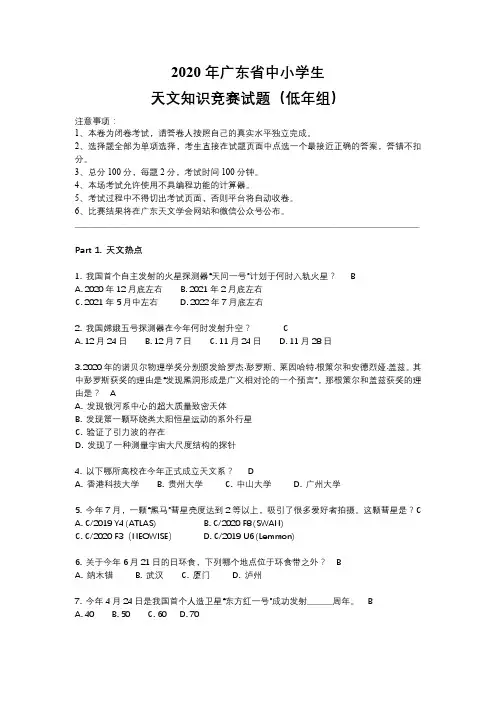
2020年广东省中小学生天文知识竞赛试题(低年组)注意事项:1、本卷为闭卷考试,请答卷人按照自己的真实水平独立完成。
2、选择题全部为单项选择,考生直接在试题页面中点选一个最接近正确的答案,答错不扣分。
3、总分100分,每题2分,考试时间100分钟。
4、本场考试允许使用不具编程功能的计算器。
5、考试过程中不得切出考试页面,否则平台将自动收卷。
6、比赛结果将在广东天文学会网站和微信公众号公布。
_______________________________________________________________________________________________ Part 1. 天文热点1. 我国首个自主发射的火星探测器“天问一号”计划于何时入轨火星? BA. 2020年12月底左右B. 2021年2月底左右C. 2021年5月中左右D. 2022年7月底左右2. 我国嫦娥五号探测器在今年何时发射升空? CA. 12月24日B. 12月7日C. 11月24日D. 11月28日3. 2020年的诺贝尔物理学奖分别颁发给罗杰·彭罗斯、莱因哈特·根策尔和安德烈娅·盖兹。
其中彭罗斯获奖的理由是“发现黑洞形成是广义相对论的一个预言”,那根策尔和盖兹获奖的理由是? AA. 发现银河系中心的超大质量致密天体B. 发现第一颗环绕类太阳恒星运动的系外行星C. 验证了引力波的存在D. 发现了一种测量宇宙大尺度结构的探针4. 以下哪所高校在今年正式成立天文系? DA. 香港科技大学B. 贵州大学C. 中山大学D. 广州大学5. 今年7月,一颗“黑马”彗星亮度达到2等以上,吸引了很多爱好者拍摄。
这颗彗星是?CA. C/2019 Y4 (ATLAS)B. C/2020 F8 (SWAN)C. C/2020 F3(NEOWISE)D. C/2019 U6 (Lemmon)6. 关于今年6月21日的日环食,下列哪个地点位于环食带之外? BA. 纳木错B. 武汉C. 厦门D. 泸州7. 今年4月24日是我国首个人造卫星“东方红一号”成功发射_______周年。
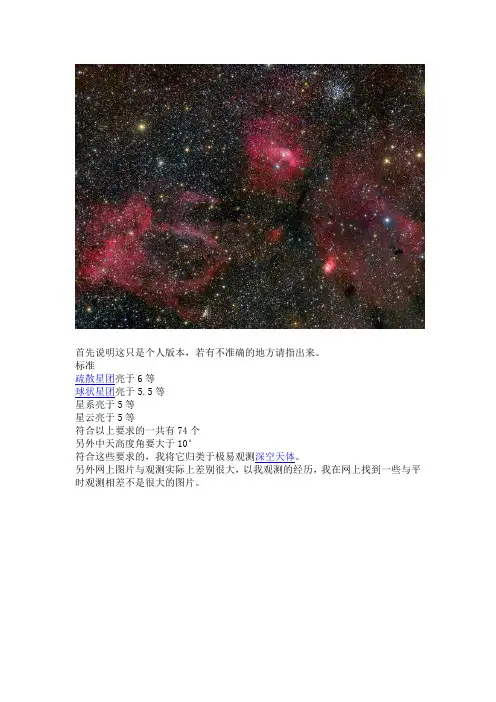
首先说明这只是个人版本,若有不准确的地方请指出来。
标准疏散星团亮于6等球状星团亮于5.5等星系亮于5等星云亮于5等符合以上要求的一共有74个另外中天高度角要大于10°符合这些要求的,我将它归类于极易观测深空天体。
另外网上图片与观测实际上差别很大,以我观测的经历,我在网上找到一些与平时观测相差不是很大的图片。
M39疏散星团M39(NGC7092),类型e,位于天鹅座。
M39是一个非常巨大却非常松散的疏散星团,视直径有32′(相当于满月大小)。
位于天津四(天鹅座α)以东约9度,略微偏北处。
它的距离大约为800光年,年龄估计在2.3亿至3亿年之间。
已经辨认出的成员星大概有30颗,分布在直径为7光年的空间内。
M1764年梅西耶将M39收入梅西耶星云星团表,但是它非常明亮。
M39中最亮的恒星(估计是HIP106293)视星等为6.83,光谱为A0III(虚拟天文馆数据)。
星桥法首先寻找到天鹅座ρ星(车府四),视星等为3.98等,光谱为G8IIIFe-0.5,在晴空无月下很容易找到(也可用双筒辅助寻找)。
接下来找到天鹅座g星,视星等为5.22,光谱为K0III。
接下来就很容易找到M39了,顺便还可以找到一个更暗淡的疏散星团NGC7082,视星等为7.2。
路径。
赤经 21h 31m 42s赤纬+48° 25′ 〃距离 824.4ly (252.8pc)视星等 4.6适合观测月份6月至12月,中天高度角73°25′(以北纬25°为基准)观赏指南,该星团适合用低倍镜下观测。
高倍镜下的M39NGC6871NGC 6871是一个较小的、很年轻、位于天鹅座的疏散星团,它被分类为II 2 p n,视星等为5.2。
该星团成员少于50颗恒星,其中大部分是蓝白的的恒星,大多都是蓝超巨星或蓝巨星还有一颗沃尔夫-拉叶星。
NGC6871的主要成员是双星SAO69405(HIP99022)视星等为6.77,是一颗沃尔夫-拉叶星;双星SAO69403(HIP99005),视星等为7.36,是一颗光谱为B1Ib蓝超巨星;它们组成这个星团的北边星群。
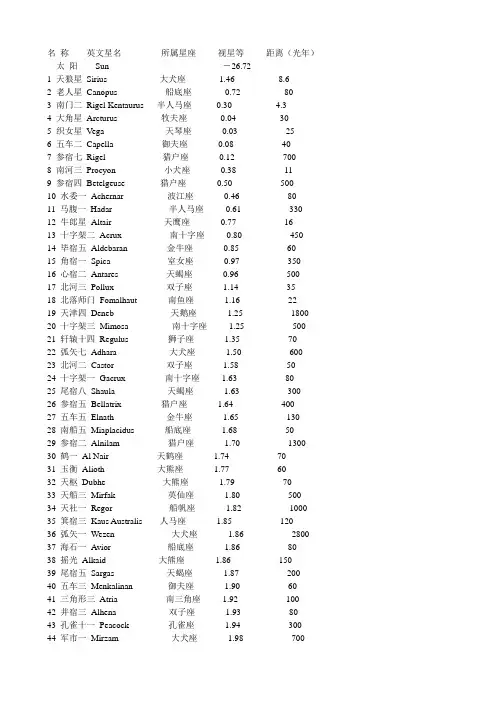
名称英文星名所属星座视星等距离(光年)太阳Sun -26.721 天狼星Sirius大犬座-1.46 8.62 老人星Canopus 船底座-0.72803 南门二Rigel Kentaurus 半人马座-0.30 4.34 大角星Arcturus牧夫座-0.04305 织女星V ega天琴座0.03256 五车二Capella御夫座0.08 407 参宿七Rigel 猎户座0.12 7008 南河三Procyon 小犬座0.38 119 参宿四Betelgeuse猎户座0.50 50010 水委一Achernar 波江座0.46 8011 马腹一Hadar半人马座0.6133012 牛郎星Altair 天鹰座0.77 1613 十字架二Acrux南十字座0.80 45014 毕宿五Aldebaran金牛座0.85 6015 角宿一Spica室女座0.97 35016 心宿二Antares天蝎座0.96 50017 北河三Pollux 双子座 1.14 3518 北落师门Fomalhaut南鱼座 1.16 2219 天津四Deneb天鹅座 1.25 180020 十字架三Mimosa南十字座 1.25 50021 轩辕十四Regulus狮子座 1.35 7022 弧矢七Adhara 大犬座 1.50 60023 北河二Castor 双子座 1.58 5024 十字架一Gacrux南十字座 1.63 8025 尾宿八Shaula 天蝎座 1.63 30026 参宿五Bellatrix猎户座 1.64 40027 五车五Elnath 金牛座 1.65 13028 南船五Miaplacidus船底座 1.68 5029 参宿二Alnilam猎户座 1.70 130030 鹤一Al Nair天鹤座 1.74 7031 玉衡Alioth 大熊座 1.77 6032 天枢Dubhe大熊座 1.79 7033 天船三Mirfak 英仙座 1.80 50034 天社一Regor船帆座 1.82 100035 箕宿三Kaus Australis 人马座 1.85 12036 弧矢一Wezen大犬座 1.86 280037 海石一A vior船底座 1.86 8038 摇光Alkaid 大熊座 1.86 15039 尾宿五Sargas 天蝎座 1.87 20040 五车三Menkalinan 御夫座 1.90 6041 三角形三Atria南三角座 1.92 10042 井宿三Alhena 双子座 1.93 8043 孔雀十一Peacock孔雀座 1.94 30044 军市一Mirzam 大犬座 1.98 70045 星宿一Alphard长蛇座 1.98 11046 娄宿三Hamal白羊座 2.00 7047 北极星Polaris小熊座 2.02 40048 斗宿四Nunki人马座 2.02 20049 土司空Diphda 鲸鱼座 2.04 6050 参宿一Alnitak猎户座 2.05 1300。
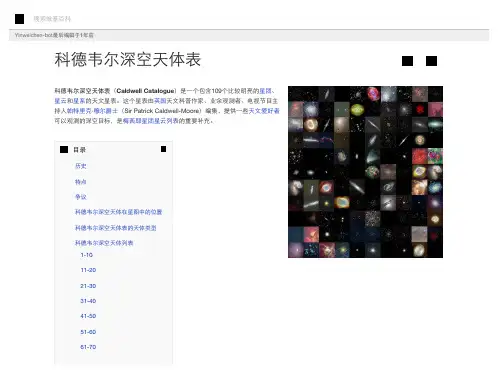
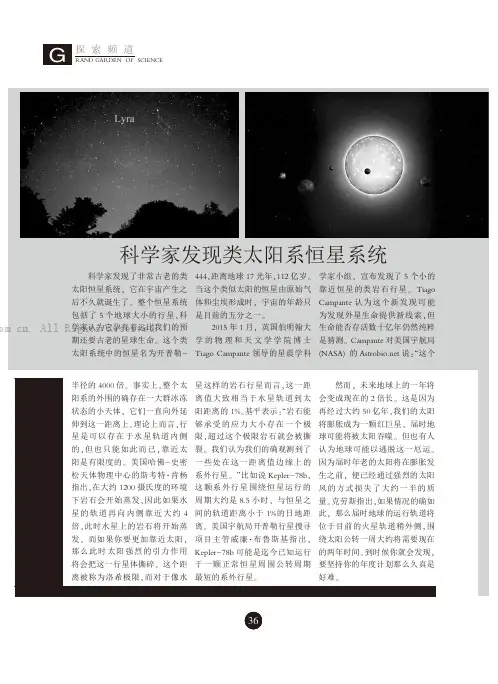
汽车雨刮槽模具项目规划设计方案1.项目背景随着汽车行业的迅速发展,汽车雨刮槽的需求也在不断增加。
传统的手工制造方式已无法满足市场需求,因此需要设计一套适用于大规模生产的模具。
2.项目目标本项目的目标是设计一套高效、精准的汽车雨刮槽模具,以提高生产效率和产品质量。
同时,还要考虑生产成本和制造周期的因素,确保项目在预期时间和成本范围内完成。
3.项目范围本项目的范围包括以下几个方面:-汽车雨刮槽的设计:根据市场需求和客户要求,对汽车雨刮槽进行设计。
-模具的设计:设计适用于汽车雨刮槽生产的模具,包括上模、下模、侧模等。
-模具制造:根据设计图纸进行模具的制造和组装。
-模具测试:对制造完成的模具进行测试和调试,确保其能够满足生产要求。
4.项目计划为了确保项目的顺利进行,需要制定一个详细的项目计划。
计划将包括以下几个阶段:-需求调研:对市场需求和客户要求进行调研,明确设计和制造的方向。
-概念设计:根据需求调研结果,进行初步的概念设计,确定模具的结构和功能。
-详细设计:在概念设计的基础上,进行详细的设计工作,包括雨刮槽的尺寸、形状等。
-模具制造:根据详细设计图纸进行模具的制造和组装工作。
-测试调试:对制造完成的模具进行测试和调试,确保其能够满足生产要求。
-交付和培训:将模具交付给客户,并对客户进行培训,确保其能够正常使用和维护模具。
5.设计方案在设计方案上,需要考虑以下几个因素:-结构设计:根据汽车雨刮槽的形状和尺寸,设计合理的模具结构,以确保生产的准确性和稳定性。
-加工工艺:选择合适的加工工艺,对模具进行精确的加工和组装,以确保模具的质量和精度。
-材料选择:选择适用于模具制造的高强度、耐磨损的材料,以延长模具的使用寿命和降低维护成本。
-模具调试:在模具制造完成后,进行测试和调试,对模具进行必要的调整,确保其能够满足生产要求。
6.风险管理在项目实施过程中,可能会面临一些风险,需要采取相应的风险管理措施:-技术风险:由于汽车雨刮槽的形状和尺寸可能会有一定的变化,导致模具设计和制造存在一定的不确定性。
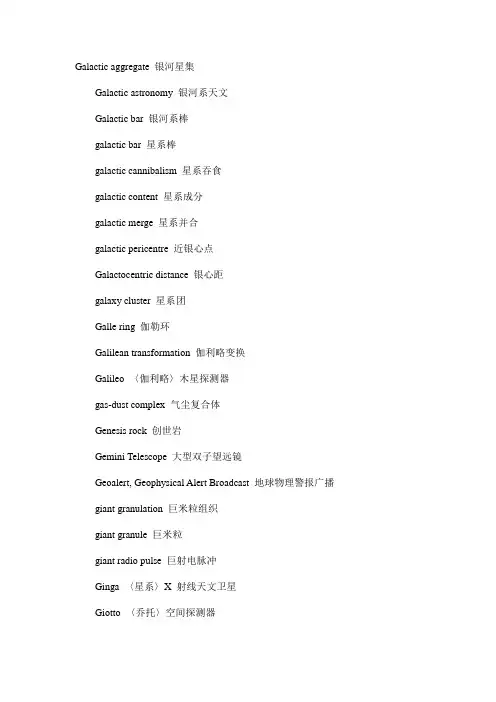
Galactic aggregate 银河星集Galactic astronomy 银河系天文Galactic bar 银河系棒galactic bar 星系棒galactic cannibalism 星系吞食galactic content 星系成分galactic merge 星系并合galactic pericentre 近银心点Galactocentric distance 银心距galaxy cluster 星系团Galle ring 伽勒环Galilean transformation 伽利略变换Galileo 〈伽利略〉木星探测器gas-dust complex 气尘复合体Genesis rock 创世岩Gemini Telescope 大型双子望远镜Geoalert, Geophysical Alert Broadcast 地球物理警报广播giant granulation 巨米粒组织giant granule 巨米粒giant radio pulse 巨射电脉冲Ginga 〈星系〉X 射线天文卫星Giotto 〈乔托〉空间探测器glassceramic 微晶玻璃glitch activity 自转突变活动global change 全球变化global sensitivity 全局灵敏度GMC, giant molecular cloud 巨分子云g-mode g 模、重力模gold spot 金斑病GONG, Global Oscillation Network 太阳全球振荡监测网GroupGPS, global positioning system 全球定位系统Granat 〈石榴〉号天文卫星grand design spiral 宏象旋涡星系gravitational astronomy 引力天文gravitational lensing 引力透镜效应gravitational micro-lensing 微引力透镜效应great attractor 巨引源Great Dark Spot 大暗斑Great White Spot 大白斑grism 棱栅GRO, Gamma-Ray Observatory γ射线天文台guidscope 导星镜GW Virginis star 室女GW 型星habitable planet 可居住行星Hakucho 〈天鹅〉X 射线天文卫星Hale Telescope 海尔望远镜halo dwarf 晕族矮星halo globular cluster 晕族球状星团Hanle effect 汉勒效应hard X-ray source 硬X 射线源Hay spot 哈伊斑HEAO, High-Energy Astronomical 〈HEAO〉高能天文台Observatoryheavy-element star 重元素星heiligenschein 灵光Helene 土卫十二helicity 螺度heliocentric radial velocity 日心视向速度heliomagnetosphere 日球磁层helioseismology 日震学helium abundance 氦丰度helium main-sequence 氦主序helium-strong star 强氦线星helium white dwarf 氦白矮星Helix galaxy (NGC 2685 )螺旋星系Herbig Ae star 赫比格Ae 型星Herbig Be star 赫比格Be 型星Herbig-Haro flow 赫比格-阿罗流Herbig-Haro shock wave 赫比格-阿罗激波hidden magnetic flux 隐磁流high-field pulsar 强磁场脉冲星highly polarized quasar (HPQ )高偏振类星体high-mass X-ray binary 大质量X 射线双星high-metallicity cluster 高金属度星团;高金属度星系团high-resolution spectrograph 高分辨摄谱仪high-resolution spectroscopy 高分辨分光high - z 大红移Hinotori 〈火鸟〉太阳探测器Hipparcos, High Precision Parallax 〈依巴谷〉卫星Collecting SatelliteHipparcos and Tycho Catalogues 〈依巴谷〉和〈第谷〉星表holographic grating 全息光栅Hooker Telescope 胡克望远镜host galaxy 寄主星系hot R Coronae Borealis star 高温北冕R 型星HST, Hubble Space Telescope 哈勃空间望远镜Hubble age 哈勃年龄Hubble distance 哈勃距离Hubble parameter 哈勃参数Hubble velocity 哈勃速度hump cepheid 驼峰造父变星Hyad 毕团星hybrid-chromosphere star 混合色球星hybrid star 混合大气星hydrogen-deficient star 缺氢星hydrogenous atmosphere 氢型大气hypergiant 特超巨星Ida 艾达(小行星243号)IEH, International Extreme Ultraviolet 〈IEH〉国际极紫外飞行器HitchhikerIERS, International Earth Rotation 国际地球自转服务Serviceimage deconvolution 图象消旋image degradation 星象劣化image dissector 析象管image distoration 星象复原image photon counting system 成象光子计数系统image sharpening 星象增锐image spread 星象扩散度imaging polarimetry 成象偏振测量imaging spectrophotometry 成象分光光度测量immersed echelle 浸渍阶梯光栅impulsive solar flare 脉冲太阳耀斑infralateral arc 外侧晕弧infrared CCD 红外CCDinfrared corona 红外冕infrared helioseismology 红外日震学infrared index 红外infrared observatory 红外天文台infrared spectroscopy 红外分光initial earth 初始地球initial mass distribution 初始质量分布initial planet 初始行星initial star 初始恒星initial sun 初始太阳inner coma 内彗发inner halo cluster 内晕族星团integrability 可积性Integral Sign galaxy (UGC 3697 )积分号星系integrated diode array (IDA )集成二极管阵intensified CCD 增强CCDIntercosmos 〈国际宇宙〉天文卫星interline transfer 行间转移intermediate parent body 中间母体intermediate polar 中介偏振星international atomic time 国际原子时International Celestial Reference 国际天球参考系Frame (ICRF )intraday variation 快速变化intranetwork element 网内元intrinsic dispersion 内廪弥散度ion spot 离子斑IPCS, Image Photon Counting System 图象光子计数器IRIS, Infrared Imager / Spectrograph 红外成象器/摄谱仪IRPS, Infrared Photometer / Spectro- 红外光度计/分光计meterirregular cluster 不规则星团; 不规则星系团IRTF, NASA Infrared Telescope 〈IRTF〉美国宇航局红外Facility 望远镜IRTS, Infrared Telescope in Space 〈IRTS〉空间红外望远镜ISO, Infrared Space Observatory 〈ISO〉红外空间天文台isochrone method 等龄线法IUE, International Ultraviolet 〈IUE〉国际紫外探测器ExplorerJewel Box (NGC 4755 )宝盒星团Jovian magnetosphere 木星磁层Jovian ring 木星环Jovian ringlet 木星细环Jovian seismology 木震学jovicentric orbit 木心轨道J-type star J 型星Juliet 天卫十一Jupiter-crossing asteroid 越木小行星Kalman filter 卡尔曼滤波器KAO, Kuiper Air-borne Observatory 〈柯伊伯〉机载望远镜Keck ⅠTelescope 凯克Ⅰ望远镜Keck ⅡTelescope 凯克Ⅱ望远镜Kuiper belt 柯伊伯带Kuiper-belt object 柯伊伯带天体Kuiper disk 柯伊伯盘LAMOST, Large Multi-Object Fibre 大型多天体分光望远镜Spectroscopic TelescopeLaplacian plane 拉普拉斯平面late cluster 晚型星系团LBT, Large Binocular Telescope 〈LBT〉大型双筒望远镜lead oxide vidicon 氧化铅光导摄象管Leo Triplet 狮子三重星系LEST, Large Earth-based Solar 〈LEST〉大型地基太阳望远镜Telescopelevel-Ⅰcivilization Ⅰ级文明level-Ⅱcivilization Ⅱ级文明level-Ⅲcivilization Ⅲ级文明Leverrier ring 勒威耶环Liapunov characteristic number 李雅普诺夫特征数(LCN )light crown 轻冕玻璃light echo 回光light-gathering aperture 聚光孔径light pollution 光污染light sensation 光感line image sensor 线成象敏感器line locking 线锁line-ratio method 谱线比法Liner, low ionization nuclear 低电离核区emission-line regionline spread function 线扩散函数LMT, Large Millimeter Telescope 〈LMT〉大型毫米波望远镜local galaxy 局域星系local inertial frame 局域惯性架local inertial system 局域惯性系local object 局域天体local star 局域恒星look-up table (LUT )对照表low-mass X-ray binary 小质量X 射线双星low-metallicity cluster 低金属度星团;低金属度星系团low-resolution spectrograph 低分辨摄谱仪low-resolution spectroscopy 低分辨分光low - z 小红移luminosity mass 光度质量luminosity segregation 光度层化luminous blue variable 高光度蓝变星lunar atmosphere 月球大气lunar chiaroscuro 月相图Lunar Prospector 〈月球勘探者〉Ly-α forest 莱曼-α 森林MACHO (massive compact halo 晕族大质量致密天体object )Magellan 〈麦哲伦〉金星探测器Magellan Telescope 〈麦哲伦〉望远镜magnetic canopy 磁蓬magnetic cataclysmic variable 磁激变变星magnetic curve 磁变曲线magnetic obliquity 磁夹角magnetic period 磁变周期magnetic phase 磁变相位magnitude range 星等范围main asteroid belt 主小行星带main-belt asteroid 主带小行星main resonance 主共振main-sequence band 主序带Mars-crossing asteroid 越火小行星Mars Pathfinder 火星探路者mass loss rate 质量损失率mass segregation 质量层化Mayall Telescope 梅奥尔望远镜Mclntosh classification 麦金托什分类McMullan camera 麦克马伦电子照相机mean motion resonance 平均运动共振membership of cluster of galaxies 星系团成员membership of star cluster 星团成员merge 并合merger 并合星系; 并合恒星merging galaxy 并合星系merging star 并合恒星mesogranulation 中米粒组织mesogranule 中米粒metallicity 金属度metallicity gradient 金属度梯度metal-poor cluster 贫金属星团metal-rich cluster 富金属星团MGS, Mars Global Surveyor 火星环球勘测者micro-arcsec astrometry 微角秒天体测量microchannel electron multiplier 微通道电子倍增管microflare 微耀斑microgravitational lens 微引力透镜microgravitational lensing 微引力透镜效应microturbulent velocity 微湍速度millimeter-wave astronomy 毫米波天文millisecond pulsar 毫秒脉冲星minimum mass 质量下限minimum variance 最小方差mixed-polarity magnetic field 极性混合磁场MMT, Multiple-Mirror Telescope 多镜面望远镜moderate-resolution spectrograph 中分辨摄谱仪moderate-resolution spectroscopy 中分辨分光modified isochrone method 改进等龄线法molecular outflow 外向分子流molecular shock 分子激波monolithic-mirror telescope 单镜面望远镜moom 行星环卫星moon-crossing asteroid 越月小行星morphological astronomy 形态天文morphology segregation 形态层化MSSSO, Mount Stromlo and Siding 斯特朗洛山和赛丁泉天文台Spring Observatorymultichannel astrometric photometer 多通道天测光度计(MAP )multi-object spectroscopy 多天体分光multiple-arc method 复弧法multiple redshift 多重红移multiple system 多重星系multi-wavelength astronomy 多波段天文multi-wavelength astrophysics 多波段天体物。
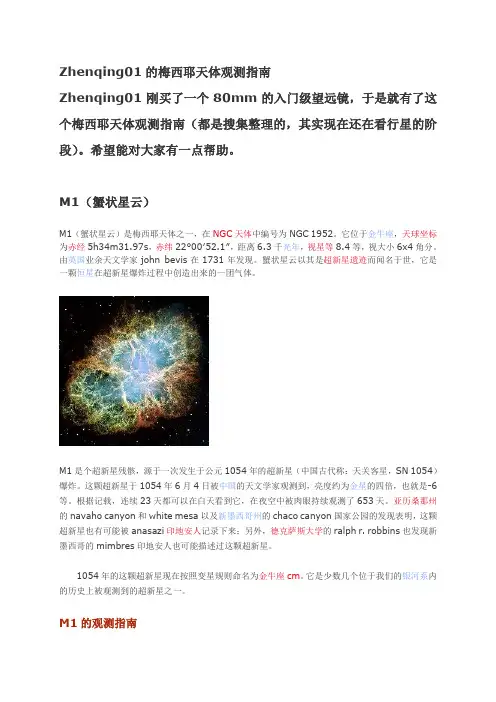
Zhenqing01的梅西耶天体观测指南Zhenqing01刚买了一个80mm的入门级望远镜,于是就有了这个梅西耶天体观测指南(都是搜集整理的,其实现在还在看行星的阶段)。
希望能对大家有一点帮助。
M1(蟹状星云)M1(蟹状星云)是梅西耶天体之一,在NGC天体中编号为NGC 1952。
它位于金牛座,天球坐标为赤经5h34m31.97s,赤纬22°00′52.1″,距离6.3千光年,视星等8.4等,视大小6x4角分。
由英国业余天文学家john bevis在1731年发现。
蟹状星云以其是超新星遗迹而闻名于世,它是一颗恒星在超新星爆炸过程中创造出来的一团气体。
M1是个超新星残骸,源于一次发生于公元1054年的超新星(中国古代称:天关客星,SN 1054)爆炸。
这颗超新星于1054年6月4日被中国的天文学家观测到,亮度约为金星的四倍,也就是-6等。
根据记载,连续23天都可以在白天看到它,在夜空中被肉眼持续观测了653天。
亚历桑那州的navaho canyon和white mesa以及新墨西哥州的chaco canyon国家公园的发现表明,这颗超新星也有可能被anasazi印地安人记录下来;另外,德克萨斯大学的ralph r. robbins也发现新墨西哥的mimbres印地安人也可能描述过这颗超新星。
1054年的这颗超新星现在按照变星规则命名为金牛座cm。
它是少数几个位于我们的银河系内的历史上被观测到的超新星之一。
M1的观测指南蟹状星云可以相当容易地通过金牛座zeta星(或者金牛座123星)找到。
这颗星是公牛的“南侧尖角”,是颗3等恒星,可以容易地在毕宿五(金牛座alpha星)的东偏东北方向找到。
M1就在zeta 星偏北1度,偏西1度的地方,就在另一颗六等恒星struve 742的偏南一点,偏西半度的位置。
这个星云可以容易地在晴朗黑暗的天空中看到,同样也很容易被非理想条件下的天光背景所掩盖。
M1在7x50或10x50的双筒镜中可以刚好被看到,呈现为一个暗斑。
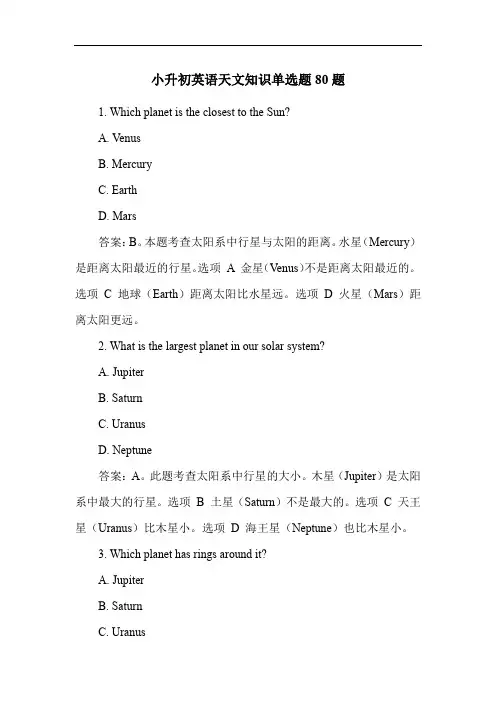
小升初英语天文知识单选题80题1. Which planet is the closest to the Sun?A. VenusB. MercuryC. EarthD. Mars答案:B。
本题考查太阳系中行星与太阳的距离。
水星(Mercury)是距离太阳最近的行星。
选项A 金星(Venus)不是距离太阳最近的。
选项C 地球 Earth)距离太阳比水星远。
选项D 火星 Mars)距离太阳更远。
2. What is the largest planet in our solar system?A. JupiterB. SaturnC. UranusD. Neptune答案:A。
此题考查太阳系中行星的大小。
木星(Jupiter)是太阳系中最大的行星。
选项B 土星(Saturn)不是最大的。
选项C 天王星 Uranus)比木星小。
选项D 海王星 Neptune)也比木星小。
3. Which planet has rings around it?A. JupiterB. SaturnC. UranusD. Neptune答案:B。
本题关于行星的特征。
土星(Saturn)是有环围绕的行星。
选项A 木星没有明显的环。
选项C 天王星的环不太显著。
选项D 海王星的环也不明显。
4. The planet known as the "Red Planet" is:A. MarsB. VenusC. JupiterD. Saturn答案:A。
这道题考查行星的别称。
火星(Mars)被称为“红色星球”。
选项 B 金星不是“红色星球”。
选项 C 木星和选项 D 土星也没有这样的称呼。
5. Which planet is often called the "Blue Planet"?A. EarthB. MarsC. JupiterD. Saturn答案:A。
本题考查行星的颜色称呼。
地球(Earth)常被称为“蓝色星球”,因为从太空中看,地球表面大部分被海洋覆盖,呈现蓝色。
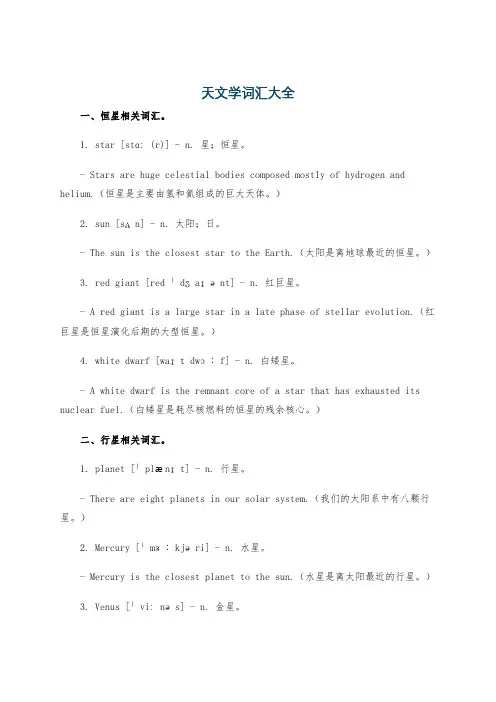
天文学词汇大全一、恒星相关词汇。
1. star [stɑː(r)] - n. 星;恒星。
- Stars are huge celestial bodies composed mostly of hydrogen and helium.(恒星是主要由氢和氦组成的巨大天体。
)2. sun [sʌn] - n. 太阳;日。
- The sun is the closest star to the Earth.(太阳是离地球最近的恒星。
)3. red giant [red ˈdʒaɪənt] - n. 红巨星。
- A red giant is a large star in a late phase of stellar evolution.(红巨星是恒星演化后期的大型恒星。
)4. white dwarf [waɪt dwɔːf] - n. 白矮星。
- A white dwarf is the remnant core of a star that has exhausted its nuclear fuel.(白矮星是耗尽核燃料的恒星的残余核心。
)二、行星相关词汇。
1. planet [ˈplænɪt] - n. 行星。
- There are eight planets in our solar system.(我们的太阳系中有八颗行星。
)2. Mercury [ˈmɜːkjəri] - n. 水星。
- Mercury is the closest planet to the sun.(水星是离太阳最近的行星。
)3. Venus [ˈviːnəs] - n. 金星。
- Venus is often called the Earth's sister planet.(金星常被称为地球的姊妹行星。
)4. Earth [ɜːθ] - n. 地球。
- The Earth is the only planet known to support life.(地球是已知唯一支持生命的行星。

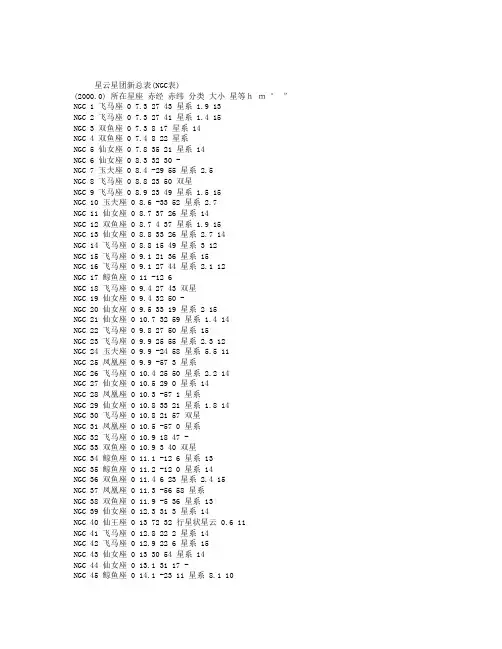
星云星团新总表(NGC表)(2000.0) 所在星座赤经赤纬分类大小星等hm°″NGC 1 飞马座 0 7.3 27 43 星系 1.9 13NGC 2 飞马座 0 7.3 27 41 星系 1.4 15NGC 3 双鱼座 0 7.3 8 17 星系 14NGC 4 双鱼座 0 7.4 8 22 星系NGC 5 仙女座 0 7.8 35 21 星系 14NGC 6 仙女座 0 8.3 32 30 -NGC 7 玉夫座 0 8.4 -29 55 星系 2.5NGC 8 飞马座 0 8.8 23 50 双星NGC 9 飞马座 0 8.9 23 49 星系 1.5 15NGC 10 玉夫座 0 8.6 -33 52 星系 2.7NGC 11 仙女座 0 8.7 37 26 星系 14NGC 12 双鱼座 0 8.7 4 37 星系 1.9 15NGC 13 仙女座 0 8.8 33 26 星系 2.7 14NGC 14 飞马座 0 8.8 15 49 星系 3 12NGC 15 飞马座 0 9.1 21 36 星系 15NGC 16 飞马座 0 9.1 27 44 星系 2.1 12NGC 17 鲸鱼座 0 11 -12 6NGC 18 飞马座 0 9.4 27 43 双星NGC 19 仙女座 0 9.4 32 50 -NGC 20 仙女座 0 9.5 33 19 星系 2 15NGC 21 仙女座 0 10.7 32 59 星系 1.4 14NGC 22 飞马座 0 9.8 27 50 星系 15NGC 23 飞马座 0 9.9 25 55 星系 2.3 12NGC 24 玉夫座 0 9.9 -24 58 星系 5.5 11NGC 25 凤凰座 0 9.9 -57 3 星系NGC 26 飞马座 0 10.4 25 50 星系 2.2 14NGC 27 仙女座 0 10.5 29 0 星系 14NGC 28 凤凰座 0 10.3 -57 1 星系NGC 29 仙女座 0 10.8 33 21 星系 1.8 14NGC 30 飞马座 0 10.8 21 57 双星NGC 31 凤凰座 0 10.5 -57 0 星系NGC 32 飞马座 0 10.9 18 47 -NGC 33 双鱼座 0 10.9 3 40 双星NGC 34 鲸鱼座 0 11.1 -12 6 星系 13NGC 35 鲸鱼座 0 11.2 -12 0 星系 14NGC 36 双鱼座 0 11.4 6 23 星系 2.4 15NGC 37 凤凰座 0 11.3 -56 58 星系NGC 38 双鱼座 0 11.9 -5 36 星系 13NGC 39 仙女座 0 12.3 31 3 星系 14NGC 40 仙王座 0 13 72 32 行星状星云 0.6 11NGC 41 飞马座 0 12.8 22 2 星系 14NGC 42 飞马座 0 12.9 22 6 星系 15NGC 43 仙女座 0 13 30 54 星系 14NGC 44 仙女座 0 13.1 31 17 -NGC 45 鲸鱼座 0 14.1 -23 11 星系 8.1 10NGC 46 双鱼座 0 14.1 5 59 单星NGC 47 鲸鱼座 0 14.5 -7 11 星系 13 NGC 48 仙女座 0 14 48 14 星系 1.7 15 NGC 49 仙女座 0 14.3 48 14 星系 15 NGC 50 鲸鱼座 0 14.7 -7 20 星系NGC 51 仙女座 0 14.6 48 15 星系 1.8 15 NGC 52 飞马座 0 14.6 18 33 星系 14 NGC 53 杜鹃座 0 14.7 -60 20 星系 2.1 NGC 54 鲸鱼座 0 15.1 -7 8 星系 14NGC 55 玉夫座 0 14.9 -39 11 星系 32.4 8 NGC 56 双鱼座 0 15.4 12 26 -NGC 57 双鱼座 0 15.4 17 18 星系 13 NGC 58 鲸鱼座 0 14.5 -7 10 -NGC 59 鲸鱼座 0 15.5 -21 27 星系 13 NGC 60 双鱼座 0 16 0 18 星系 15NGC 61 双鱼座 0 16.5 -6 14 星系 15 NGC 62 鲸鱼座 0 17.1 -13 28 星系 14 NGC 63 双鱼座 0 17.7 11 27 星系 1.9 13 NGC 64 鲸鱼座 0 17.5 -6 51 星系 14 NGC 65 鲸鱼座 0 19.1 -22 54 星系 15 NGC 66 鲸鱼座 0 19.2 -22 57 星系 14 NGC 67 仙女座 0 18.2 30 4 星系 0.4 16 NGC 68 仙女座 0 18.3 30 4 星系 1.5 13 NGC 69 仙女座 0 18.3 30 2 星系 0.4 14 NGC 70 仙女座 0 18.4 30 5 星系 1.7 15 NGC 71 仙女座 0 18.4 30 4 星系 1.8 13 NGC 72 仙女座 0 18.5 30 2 星系 1.4 13 NGC 73 鲸鱼座 0 18.8 -15 21 星系 13 NGC 74 仙女座 0 18.9 30 3 星系 16NGC 75 双鱼座 0 19.5 6 25 星系 15NGC 76 仙女座 0 19.6 29 56 星系 14 NGC 77 鲸鱼座 0 20 -22 31 -NGC 78 双鱼座 0 20.4 0 49 星系 14NGC 79 仙女座 0 21 22 34 星系 15NGC 80 仙女座 0 21.2 22 21 星系 2.5 12 NGC 81 仙女座 0 21.2 22 22 星系NGC 82 仙女座 0 21.4 22 26 星系 1.3 14 NGC 83 仙女座 0 21.4 22 26 星系 1.6 12 NGC 84 仙女座 0 21.5 22 36 星系 17 NGC 85 仙女座 0 21.4 22 30 星系 15 NGC 86 仙女座 0 21.5 22 33 星系 15 NGC 87 凤凰座 0 21.2 -48 38 星系NGC 88 凤凰座 0 21.3 -48 39 星系NGC 89 凤凰座 0 21.3 -48 41 星系NGC 90 仙女座 0 21.9 22 25 单星NGC 91 仙女座 0 21.8 22 25 星系 2.5 15 NGC 92 凤凰座 0 21.5 -48 38 星系NGC 93 仙女座 0 22 22 25 星系 14NGC 94 仙女座 0 22.2 22 28 星系 15NGC 96 仙女座 0 22.3 22 33 星系 17NGC 97 仙女座 0 22.4 29 44 星系 13NGC 98 凤凰座 0 22.8 -45 16 星系 1.8NGC 99 双鱼座 0 24 15 47 星系 1.7 14NGC 100 双鱼座 0 24 16 29 星系 5.8NGC 101 玉夫座 0 23.9 -32 34 星系 13NGC 102 鲸鱼座 0 24.4 -13 57 星系 14NGC 103 仙后座 0 25.3 61 21 疏散星团 5 9 NGC 104 杜鹃座 0 24.1 -72 5 球状星团 30.9 4 NGC 105 双鱼座 0 25.3 12 53 星系 1.2 13 NGC 106 双鱼座 0 24.7 -5 10 星系NGC 107 鲸鱼座 0 25.6 -8 17 星系NGC 108 仙女座 0 25.9 29 13 星系 13NGC 109 仙女座 0 26.2 21 49 星系 15NGC 110 仙后座 0 27.4 71 23 疏散星团NGC 111 鲸鱼座 0 26.7 -2 38 -NGC 112 仙女座 0 26.7 31 43 星系 14NGC 113 鲸鱼座 0 27 -2 30 星系 13NGC 114 鲸鱼座 0 27.1 -1 47 星系 15NGC 115 玉夫座 0 26.8 -33 41 星系NGC 116 鲸鱼座 0 27.2 -7 42 星系 14NGC 117 鲸鱼座 0 27.2 1 19 星系 15NGC 118 鲸鱼座 0 27.3 -1 47 星系 15NGC 119 凤凰座 0 27.1 -56 59 星系NGC 120 鲸鱼座 0 27.5 -1 31 星系 1.8 15 NGC 121 杜鹃座 0 26.8 -71 32 球状星团 1.5 10 NGC 122 鲸鱼座 0 27.7 -1 38 ?NGC 123 鲸鱼座 0 27.8 -1 36 ?NGC 124 鲸鱼座 0 27.9 -1 49 星系 1.6 14 NGC 125 双鱼座 0 28.8 2 50 星系 2 12NGC 126 双鱼座 0 29.1 2 49 星系 1.4 16NGC 127 双鱼座 0 29.2 2 52 星系 1 14NGC 128 双鱼座 0 29.2 2 51 星系 3.4 11NGC 129 仙后座 0 29.9 60 14 疏散星团 21 6 NGC 130 双鱼座 0 29.3 2 52 星系 0.9 14NGC 131 玉夫座 0 29.6 -33 16 星系 2.1NGC 132 鲸鱼座 0 30.2 2 6 星系 2 14NGC 133 仙后座 0 31.2 63 22 疏散星团 7 9 NGC 134 玉夫座 0 30.4 -33 15 星系 8.1 10 NGC 135 鲸鱼座 0 31.8 -13 22 -NGC 136 仙后座 0 31.5 61 32 疏散星团 1 NGC 137 双鱼座 0 31.1 10 11 星系 14NGC 138 双鱼座 0 31 5 10 星系 15NGC 139 双鱼座 0 31 5 5 星系 15NGC 140 仙女座 0 31.3 30 47 星系 14NGC 141 双鱼座 0 31.4 5 11 星系 15NGC 142 鲸鱼座 0 31.3 -22 37 星系 14NGC 143 鲸鱼座 0 31.4 -22 34 星系 15NGC 145 鲸鱼座 0 31.7 -5 9 星系 1.8 12 NGC 146 仙后座 0 33.1 63 18 疏散星团 7 9 NGC 147 仙后座 0 33.2 48 30 星系 12.9 9 NGC 148 玉夫座 0 34.3 -31 47 星系 2.4 12 NGC 149 仙女座 0 33.7 30 43 星系 15 NGC 150 玉夫座 0 34.3 -27 48 星系 4.2 11 NGC 151 鲸鱼座 0 34 -9 42 星系 3.7 11 NGC 152 杜鹃座 0 32.8 -73 9 球状星团 12 NGC 153 鲸鱼座 0 34 -9 42 -NGC 154 鲸鱼座 0 34.1 -12 39 星系 14 NGC 155 鲸鱼座 0 34.7 -10 46 星系 13 NGC 156 鲸鱼座 0 34.6 -8 21 双星NGC 157 鲸鱼座 0 34.8 -8 24 星系 4.3 10 NGC 158 鲸鱼座 0 34.9 -8 19 双星NGC 159 凤凰座 0 34.6 -55 47 星系NGC 160 仙女座 0 36.1 23 57 星系 3.2 12 NGC 161 鲸鱼座 0 35.5 -2 50 星系 15 NGC 162 仙女座 0 36.1 23 58 星系NGC 163 鲸鱼座 0 36 -10 7 星系 1.4 12 NGC 164 双鱼座 0 36.5 2 45 星系 16NGC 165 鲸鱼座 0 36.5 -10 6 星系 1.6 13 NGC 166 鲸鱼座 0 35.8 -13 37 星系 15 NGC 167 鲸鱼座 0 35.3 -23 22 星系 13 NGC 168 鲸鱼座 0 36.7 -22 36 星系 14 NGC 169 仙女座 0 36.9 23 59 星系 3 13 NGC 170 鲸鱼座 0 36.7 1 51 星系 15NGC 171 鲸鱼座 0 37.4 -19 56 -NGC 172 鲸鱼座 0 37.3 -22 36 星系 2.6 NGC 173 鲸鱼座 0 37.2 1 56 星系 3.5 15 NGC 174 玉夫座 0 36.9 -29 29 星系 14 NGC 175 鲸鱼座 0 37.4 -19 56 星系 2.6 12 NGC 176 杜鹃座 0 35.8 -73 11 疏散星团 12 NGC 177 鲸鱼座 0 37.5 -22 34 星系 13 NGC 178 鲸鱼座 0 39.1 -14 10 星系 2 12 NGC 179 鲸鱼座 0 37.8 -17 53 星系 14 NGC 180 双鱼座 0 38 8 38 星系 2.6 14 NGC 181 仙女座 0 38.2 29 28 星系 15 NGC 182 双鱼座 0 38.2 2 44 星系 2.3 12 NGC 183 仙女座 0 38.3 29 30 星系 14 NGC 184 仙女座 0 38.5 29 26 星系 15 NGC 185 仙后座 0 39 48 20 星系 11.5 9 NGC 186 双鱼座 0 38.5 3 9 星系 15NGC 187 鲸鱼座 0 39.6 -14 41 星系 13 NGC 188 仙王座 0 44 85 20 疏散星团 14 8 NGC 189 仙后座 0 39.6 61 4 疏散星团 4 8 NGC 190 双鱼座 0 38.9 7 2 星系 1 14 NGC 191 鲸鱼座 0 39 -9 0 星系 1.5 12 NGC 192 鲸鱼座 0 39.3 0 51 星系 2.3 14NGC 194 双鱼座 0 39.3 3 2 星系 1.9 12 NGC 195 鲸鱼座 0 39.6 -9 12 星系 1.3 NGC 196 鲸鱼座 0 39.3 0 54 星系 14NGC 197 鲸鱼座 0 39.4 0 53 星系 15NGC 198 双鱼座 0 39.4 2 48 星系 1.3 12 NGC 199 双鱼座 0 39.6 3 7 星系 15NGC 200 双鱼座 0 39.6 2 53 星系 2 14 NGC 201 鲸鱼座 0 39.7 0 51 星系 2.2 15 NGC 202 双鱼座 0 39.7 3 31 星系 15NGC 203 双鱼座 0 39.7 3 26 星系 15NGC 204 双鱼座 0 39.8 3 17 星系 14NGC 205 仙女座 0 40.4 41 41 星系 17.4 8 NGC 206 仙女座 0 40.6 40 44 星云&星团NGC 207 鲸鱼座 0 40 -14 18 -NGC 208 双鱼座 0 40.4 2 44 星系 15NGC 209 鲸鱼座 0 39.1 -18 38 星系 14 NGC 210 鲸鱼座 0 40.6 -13 52 星系 5.4 10 NGC 211 双鱼座 0 41 3 26 单星NGC 212 凤凰座 0 40.1 -56 10 星系NGC 213 双鱼座 0 41.2 16 28 星系 15NGC 214 仙女座 0 41.5 25 30 星系 2.1 12 NGC 215 凤凰座 0 40.8 -56 13 星系 1.2 NGC 216 鲸鱼座 0 41.4 -21 3 星系 1.8 13 NGC 217 鲸鱼座 0 41.5 -10 2 星系 3.3 NGC 218 仙女座 0 41.8 36 21 星系 15NGC 219 鲸鱼座 0 42.3 0 54 星系 15NGC 220 杜鹃座 0 40.5 -73 24 疏散星团 11 NGC 221 仙女座 0 42.7 40 52 星系 7.6 8 NGC 222 杜鹃座 0 40.6 -73 24 疏散星团 11 NGC 223 鲸鱼座 0 42.7 0 51 星系 14NGC 224 仙女座 0 42.7 41 16 星系 178 3 NGC 225 仙后座 0 43.4 61 47 疏散星团 12 7 NGC 226 仙女座 0 42.8 32 34 星系 14NGC 227 鲸鱼座 0 42.6 -1 32 星系 2.1 13 NGC 228 仙女座 0 42.8 23 30 星系 15NGC 229 仙女座 0 43 23 29 星系 14NGC 230 鲸鱼座 0 42.4 -23 38 星系 15 NGC 231 杜鹃座 0 41 -73 22 疏散星团 12 NGC 232 鲸鱼座 0 42.7 -23 34 星系 14 NGC 233 仙女座 0 43.4 30 35 星系 14NGC 234 双鱼座 0 43.4 14 20 星系 13NGC 235 鲸鱼座 0 42.8 -23 33 星系 14 NGC 236 双鱼座 0 43.5 2 56 星系 14NGC 237 鲸鱼座 0 43.5 0 7 星系 1.8 14 NGC 238 凤凰座 0 43.4 -50 11 星系 1.9 NGC 239 鲸鱼座 0 44.6 -3 47 -NGC 240 双鱼座 0 45.1 6 8 星系 15NGC 241 杜鹃座 0 43.4 -73 26 -NGC 243 仙女座 0 45.9 29 56 星系 14NGC 244 鲸鱼座 0 45.8 -15 36 星系 1.3 13 NGC 245 鲸鱼座 0 46.1 -1 44 星系 1.4 13 NGC 246 鲸鱼座 0 47 -11 53 行星状星云 3.8 8 NGC 247 鲸鱼座 0 47.1 -20 46 星系 20 8NGC 248 杜鹃座 0 45.4 -73 23 星云NGC 249 杜鹃座 0 45.4 -73 5 星云NGC 250 双鱼座 0 47.3 7 55 星系 15NGC 251 双鱼座 0 47.8 19 34 星系 14NGC 252 仙女座 0 48 27 38 星系 1.8 13NGC 253 玉夫座 0 47.6 -25 17 星系 25.1 7 NGC 254 玉夫座 0 47.5 -31 25 星系 2.1 11 NGC 255 鲸鱼座 0 47.8 -11 28 星系 3.1 11 NGC 256 杜鹃座 0 45.9 -73 30 星云&星团 12 NGC 257 双鱼座 0 48.1 8 19 星系 2.1 14NGC 258 仙女座 0 48.2 27 38 星系 15NGC 259 鲸鱼座 0 48.1 -2 47 星系 3.2NGC 260 仙女座 0 48.6 27 42 星系 1 14NGC 261 杜鹃座 0 46.5 -73 7 星云NGC 262 仙女座 0 48.8 31 57 星系 1.4 15 NGC 263 鲸鱼座 0 48.9 -13 6 星系 14NGC 264 玉夫座 0 48.3 -38 14 星系 0.9NGC 265 杜鹃座 0 47.6 -73 29 球状星团 12 NGC 266 双鱼座 0 49.8 32 16 星系 3.2 13 NGC 267 杜鹃座 0 48 -73 17 星云&星团NGC 268 鲸鱼座 0 50.2 -5 12 星系 1.7 13 NGC 269 杜鹃座 0 48.5 -73 32 球状星团 12 NGC 270 鲸鱼座 0 50.7 -8 39 星系 13NGC 271 鲸鱼座 0 50.8 -1 53 星系 2.5 13 NGC 272 仙女座 0 51.4 35 50 疏散星团NGC 273 鲸鱼座 0 50.8 -6 53 星系 2.6 13 NGC 274 鲸鱼座 0 51 -7 3 星系 1.7 13NGC 275 鲸鱼座 0 51.1 -7 4 星系 1.5 12NGC 276 鲸鱼座 0 52.1 -22 41 星系 14NGC 277 鲸鱼座 0 51.5 -8 35 星系 13NGC 278 仙后座 0 52.1 47 33 星系 2.2 10 NGC 279 鲸鱼座 0 52.3 -2 12 星系 1.8 14 NGC 280 仙女座 0 52.5 24 20 星系 14NGC 281 仙后座 0 52.8 56 37 星云&星团 35 7 NGC 282 双鱼座 0 52.8 30 37 星系 14NGC 283 鲸鱼座 0 53.3 -13 11 星系 14NGC 284 鲸鱼座 0 53.6 -13 9 星系 15NGC 285 鲸鱼座 0 53.7 -13 10 星系NGC 286 鲸鱼座 0 53.6 -13 6 星系 14NGC 287 双鱼座 0 53.6 32 29 星系 15NGC 288 玉夫座 0 52.8 -26 35 球状星团 13.8 8 NGC 289 玉夫座 0 52.7 -31 12 星系 3.7 12 NGC 290 杜鹃座 0 51.3 -73 9 疏散星团 12NGC 292 杜鹃座 0 52.8 -72 50 星系NGC 293 鲸鱼座 0 54.3 -7 14 星系 14NGC 294 杜鹃座 0 52.1 -73 21 星云NGC 295 双鱼座 0 55.2 31 31 星系 13NGC 296 双鱼座 0 55.4 31 40 星系 15NGC 297 鲸鱼座 0 55 -7 21 双星NGC 298 鲸鱼座 0 55 -7 21 星系 13NGC 299 杜鹃座 0 54 -72 10 星云&星团 11 NGC 300 玉夫座 0 54.9 -37 41 星系 20 9NGC 301 鲸鱼座 0 56.3 -10 40 星系NGC 302 鲸鱼座 0 56.4 -10 39 单星NGC 303 鲸鱼座 0 54.8 -16 40 星系NGC 304 仙女座 0 56.1 24 7 星系 14NGC 305 双鱼座 0 56 12 6 -NGC 306 杜鹃座 0 54.9 -72 13 星云&星团 12 NGC 307 鲸鱼座 0 56.6 -1 46 星系 14NGC 308 鲸鱼座 0 56.4 -1 47 单星NGC 309 鲸鱼座 0 56.7 -9 55 星系 3.1 11 NGC 310 鲸鱼座 0 56.9 -1 46 单星NGC 311 双鱼座 0 57.6 30 16 星系 14NGC 312 凤凰座 0 56.3 -52 47 星系 1.8NGC 313 双鱼座 0 57.8 30 21 星系 3.6 12 NGC 314 玉夫座 0 56.9 -31 58 星系 1.2NGC 315 双鱼座 0 57.8 30 21 星系 3.2 13 NGC 316 双鱼座 0 57.8 30 21 星系 3.6 12 NGC 317 仙女座 0 57.6 43 47 星系 15NGC 318 双鱼座 0 58.1 30 25 星系 15NGC 319 凤凰座 0 57 -43 50 星系 1.1NGC 320 鲸鱼座 0 58.8 -20 50 星系 15NGC 321 鲸鱼座 0 57.4 -5 2 星系NGC 322 凤凰座 0 57.2 -43 44 星系 1.3NGC 323 凤凰座 0 56.7 -52 59 星系 1.3NGC 324 凤凰座 0 58.6 -40 30 星系NGC 325 鲸鱼座 0 57.9 -5 8 星系 16NGC 326 双鱼座 0 58.4 26 52 星系 1.5 13 NGC 327 鲸鱼座 0 57.9 -5 8 星系 1.9 13NGC 328 凤凰座 0 57 -52 55 星系 2.8NGC 329 鲸鱼座 0 58 -5 4 星系 1.9 13NGC 330 杜鹃座 0 56.2 -72 29 疏散星团 2 9 NGC 331 鲸鱼座 0 58.6 -2 43 ?NGC 332 双鱼座 0 58.8 7 6 星系 15NGC 333 鲸鱼座 0 58.8 -16 29 星系 16NGC 334 玉夫座 0 58.8 -35 8 星系NGC 335 鲸鱼座 0 59.3 -18 14 星系 1.2NGC 336 鲸鱼座 0 58.8 -18 46 星系 12NGC 337 鲸鱼座 0 59.8 -7 35 星系 2.8 11 NGC 338 双鱼座 1 0.6 30 39 星系 14NGC 339 杜鹃座 0 57.7 -74 29 球状星团 2.2 11NGC 341 鲸鱼座 1 0.8 -9 11 星系 13NGC 342 鲸鱼座 1 0.8 -6 47 星系 14NGC 343 鲸鱼座 1 0.8 -23 14 单星NGC 344 鲸鱼座 1 1.6 -23 16 星系 0.9NGC 345 鲸鱼座 1 1.4 -6 54 星系 13NGC 346 杜鹃座 0 59.1 -72 11 星云&星团 14 10 NGC 347 鲸鱼座 1 1.4 -6 49 星系 14NGC 348 凤凰座 1 0.9 -53 15 星系 1.1NGC 349 鲸鱼座 1 1.9 -6 49 星系 13NGC 350 鲸鱼座 1 2 -6 49 星系 15NGC 351 鲸鱼座 1 2.1 -1 55 星系 14NGC 352 鲸鱼座 1 2.1 -4 15 星系 2.7 13NGC 353 鲸鱼座 1 2.6 -1 56 星系 14NGC 354 双鱼座 1 3.3 22 20 星系 0.9 14NGC 355 鲸鱼座 1 3.2 -6 20 星系 15NGC 356 鲸鱼座 1 3.3 -7 0 星系 13NGC 357 鲸鱼座 1 3.4 -6 20 星系 2.6 11NGC 358 仙后座 1 5.2 62 2 -NGC 359 鲸鱼座 1 4.4 0 45 星系 15NGC 360 杜鹃座 1 2.9 -65 37 星系 3.3NGC 361 杜鹃座 1 2.2 -71 33 球状星团 1.5 11 NGC 362 杜鹃座 1 3.2 -70 51 球状星团 12.9 6 NGC 363 鲸鱼座 1 6.1 -16 34 星系 15NGC 364 鲸鱼座 1 4.6 0 51 星系 14NGC 365 玉夫座 1 4.1 -35 7 星系NGC 366 仙后座 1 6.4 62 14 疏散星团 3NGC 367 鲸鱼座 1 4.9 -12 9 ?NGC 368 凤凰座 1 4.4 -43 16 星系NGC 369 鲸鱼座 1 5.1 -17 45 星系 1.3NGC 370 双鱼座 1 6.6 32 25 -NGC 371 杜鹃座 1 3.3 -72 5 疏散星团 8NGC 372 双鱼座 1 6.7 32 26 三重星NGC 373 双鱼座 1 7 32 18 星系NGC 374 双鱼座 1 7.1 32 46 星系 14NGC 375 双鱼座 1 7.1 32 21 星系 1.3 16NGC 376 杜鹃座 1 3.9 -72 49 -NGC 377 鲸鱼座 1 6.3 -20 3 三重星NGC 378 玉夫座 1 6.2 -30 11 星系 14NGC 379 双鱼座 1 7.3 32 31 星系 1.8 12NGC 380 双鱼座 1 7.3 32 29 星系 1.6 12NGC 381 仙后座 1 8.3 61 35 疏散星团 6 9NGC 382 双鱼座 1 7.4 32 24 星系 0.4 14NGC 383 双鱼座 1 7.4 32 25 星系 2.3 11NGC 384 双鱼座 1 7.4 32 18 星系 1.1 13NGC 385 双鱼座 1 7.4 32 19 星系 1.5 12NGC 386 双鱼座 1 7.5 32 22 星系 0.9 14NGC 387 双鱼座 1 7.5 32 23 星系NGC 388 双鱼座 1 7.8 32 19 星系 0.8 14NGC 390 双鱼座 1 8.1 32 27 星系NGC 391 鲸鱼座 1 7.5 0 56 星系 14NGC 392 双鱼座 1 8.4 33 7 星系 14NGC 393 仙女座 1 8.6 39 40 星系 13NGC 394 双鱼座 1 8.4 33 8 星系 15NGC 395 杜鹃座 1 5.3 -72 0 -NGC 396 双鱼座 1 8 4 32 星系NGC 397 双鱼座 1 8.5 33 6 星系 15NGC 398 双鱼座 1 8.8 32 30 星系 15NGC 399 双鱼座 1 9 32 37 星系 14NGC 400 双鱼座 1 9 32 44 -NGC 401 双鱼座 1 9.1 32 46 -NGC 402 双鱼座 1 9.2 32 49 -NGC 403 双鱼座 1 9.2 32 45 星系 2.1 13 NGC 404 仙女座 1 9.4 35 43 星系 4.4 10 NGC 405 凤凰座 1 8.3 -46 40 双星NGC 406 杜鹃座 1 7.4 -69 53 星系 3.8 12 NGC 407 双鱼座 1 10.6 33 7 星系 2 14NGC 408 双鱼座 1 10.9 33 6 星系NGC 409 玉夫座 1 9.5 -35 48 星系 1.5NGC 410 双鱼座 1 11 33 9 星系 2.6 13NGC 411 杜鹃座 1 7.9 -71 46 -NGC 412 鲸鱼座 1 10.3 -20 1 -NGC 413 鲸鱼座 1 9.5 -2 50 星系 16NGC 414 双鱼座 1 11.3 33 6 星系 14NGC 415 玉夫座 1 10.2 -35 29 星系NGC 416 杜鹃座 1 8.1 -72 21 球状星团 1.1 11 NGC 417 鲸鱼座 1 11.1 -18 10 星系 15NGC 418 玉夫座 1 10.6 -30 13 星系 2.3 13 NGC 419 杜鹃座 1 8.3 -72 53 球状星团 2.6 10 NGC 420 双鱼座 1 12.1 32 6 星系 13NGC 421 双鱼座 1 12.1 32 9 -NGC 422 杜鹃座 1 8.9 -71 46 -NGC 423 玉夫座 1 11.4 -29 13 星系 14NGC 424 玉夫座 1 11.5 -38 5 星系 2.1NGC 425 仙女座 1 13 38 48 星系 13NGC 426 鲸鱼座 1 12.9 0 17 星系 14NGC 427 玉夫座 1 12.5 -32 3 星系 15NGC 428 鲸鱼座 1 12.9 0 59 星系 4.1 11 NGC 429 鲸鱼座 1 13 0 20 星系 14NGC 430 鲸鱼座 1 13.1 0 15 星系 13NGC 431 仙女座 1 14.2 33 44 星系 14NGC 432 杜鹃座 1 11.8 -61 32 星系 1.5 NGC 433 仙后座 1 15.3 60 8 疏散星团 3 NGC 434 杜鹃座 1 12.2 -58 15 星系 1.9 13 NGC 435 鲸鱼座 1 14 2 4 星系 15NGC 436 仙后座 1 15.6 58 49 疏散星团 6 8 NGC 437 双鱼座 1 14.4 5 56 星系 14NGC 439 玉夫座 1 13.8 -31 45 星系 13 NGC 440 杜鹃座 1 12.9 -58 17 星系 1 NGC 441 玉夫座 1 14 -31 47 星系 14NGC 442 鲸鱼座 1 14.6 -1 1 星系 1.2 15 NGC 443 双鱼座 1 15.1 33 23 星系 14NGC 444 双鱼座 1 15.9 31 5 星系 14NGC 445 鲸鱼座 1 14.9 1 56 星系 15NGC 446 双鱼座 1 14.9 4 11 星系 15NGC 447 双鱼座 1 15.6 33 4 星系 2.6 14 NGC 448 鲸鱼座 1 15.3 -1 37 星系 13NGC 449 双鱼座 1 16.1 33 5 星系 0.7 14 NGC 450 鲸鱼座 1 15.5 0 52 星系 3.2 12 NGC 451 双鱼座 1 16.2 33 4 星系 15NGC 452 双鱼座 1 16.3 31 2 星系 14NGC 453 双鱼座 1 16.3 33 5 三重星NGC 454 凤凰座 1 14.4 -55 24 星系 1.9 NGC 455 双鱼座 1 16 5 11 星系 14NGC 456 杜鹃座 1 14.4 -73 17 星云 15 NGC 457 仙后座 1 19.1 58 20 疏散星团 13 6 NGC 458 杜鹃座 1 14.9 -71 33 -NGC 459 双鱼座 1 18 17 33 星系 15NGC 460 杜鹃座 1 14.8 -72 18 星云&星团NGC 461 玉夫座 1 17.3 -33 50 星系 1.2 NGC 462 双鱼座 1 18.1 4 14 星系NGC 463 双鱼座 1 18.9 16 19 星系 15NGC 464 仙女座 1 19 34 58 星系NGC 465 杜鹃座 1 15.5 -73 20 疏散星团NGC 466 杜鹃座 1 17.2 -58 55 星系 2.1 NGC 467 双鱼座 1 19.2 3 18 星系 2.4 11 NGC 468 双鱼座 1 19.8 32 47 星系 15NGC 469 双鱼座 1 19.4 14 53 星系 15NGC 470 双鱼座 1 19.7 3 25 星系 3 11 NGC 471 双鱼座 1 19.9 14 47 星系 14NGC 472 双鱼座 1 20.5 32 43 星系 14NGC 473 双鱼座 1 19.9 16 33 星系 2.2 13 NGC 474 双鱼座 1 20.1 3 25 星系 7.9 11 NGC 475 双鱼座 1 20 14 51 星系NGC 476 双鱼座 1 20.2 16 1 星系 15NGC 477 仙女座 1 21.3 40 29 星系 14NGC 478 鲸鱼座 1 20.2 -22 22 星系 15 NGC 479 双鱼座 1 21.3 3 52 星系 15NGC 480 鲸鱼座 1 20.9 -9 52 -NGC 481 鲸鱼座 1 21 -9 12 星系 14NGC 482 凤凰座 1 20.3 -40 57 星系NGC 483 双鱼座 1 22 33 32 星系 14NGC 484 杜鹃座 1 19.6 -58 31 星系 2.2 NGC 485 双鱼座 1 21.4 7 1 星系 1.9 14 NGC 486 双鱼座 1 22.1 5 24 星系 15NGC 488 双鱼座 1 21.8 5 15 星系 5.2 10 NGC 489 双鱼座 1 21.8 9 12 星系 13 NGC 490 双鱼座 1 22.1 5 22 星系 15 NGC 491 玉夫座 1 21.4 -34 3 星系 1.5 13 NGC 492 双鱼座 1 22.2 5 25 星系 15 NGC 493 鲸鱼座 1 22.2 0 57 星系 3.8 12 NGC 494 双鱼座 1 23 33 11 星系 14NGC 495 双鱼座 1 22.9 33 28 星系 1.5 13 NGC 496 双鱼座 1 23.3 33 33 星系 14 NGC 497 鲸鱼座 1 22.4 0 53 星系 2.4 14 NGC 498 双鱼座 1 23.3 33 30 星系 16 NGC 499 双鱼座 1 23.2 33 28 星系 2 12 NGC 500 双鱼座 1 22.7 5 24 星系 15 NGC 501 双鱼座 1 23.4 33 27 星系 15 NGC 502 双鱼座 1 22.8 9 3 星系 14NGC 503 双鱼座 1 23.5 33 21 星系 15 NGC 504 双鱼座 1 23.5 33 13 星系 14 NGC 505 双鱼座 1 22.9 9 28 星系 15 NGC 506 双鱼座 1 23.6 33 14 -NGC 507 双鱼座 1 23.7 33 15 星系 4.3 11 NGC 508 双鱼座 1 23.7 33 17 星系 1.6 12 NGC 509 双鱼座 1 23.4 9 26 星系 1.7 15 NGC 510 双鱼座 1 23.7 33 26 星系NGC 511 双鱼座 1 23.5 11 17 星系 15 NGC 512 仙女座 1 24 33 55 星系 14NGC 513 仙女座 1 23.8 33 49 星系 13 NGC 514 双鱼座 1 24.1 12 55 星系 3.5 11 NGC 515 双鱼座 1 24.6 33 29 星系 14 NGC 516 双鱼座 1 24.1 9 33 星系 1.6 14 NGC 517 双鱼座 1 24.7 33 27 星系 13 NGC 518 双鱼座 1 24.3 9 20 星系 1.9 14 NGC 519 鲸鱼座 1 24.5 -1 38 星系NGC 520 双鱼座 1 24.6 3 48 星系 4.8 11 NGC 521 鲸鱼座 1 24.6 1 44 星系 3.4 13 NGC 522 双鱼座 1 24.8 10 0 星系 2.8 14 NGC 523 仙女座 1 25.3 34 2 星系 3.1 14 NGC 524 双鱼座 1 24.8 9 32 星系 3.2 10 NGC 525 双鱼座 1 24.8 9 42 星系 14 NGC 526 玉夫座 1 23.9 -35 3 星系NGC 527 玉夫座 1 24 -35 6 星系NGC 528 仙女座 1 25.5 33 41 星系 13 NGC 529 仙女座 1 25.7 34 44 星系 13 NGC 530 鲸鱼座 1 24.7 -1 35 星系 1.9 14 NGC 531 仙女座 1 26.3 34 45 星系 15 NGC 532 双鱼座 1 25.3 9 16 星系 2.8 14 NGC 533 鲸鱼座 1 25.5 1 46 星系 3.7 13 NGC 534 玉夫座 1 24.6 -38 7 星系NGC 535 鲸鱼座 1 25.5 -1 25 星系 1.3 15NGC 537 仙女座 1 26.3 34 5 -NGC 538 鲸鱼座 1 25.4 -1 33 星系 1.3 15 NGC 539 鲸鱼座 1 25.3 -18 9 星系 1.8 14 NGC 540 鲸鱼座 1 27.1 -20 2 星系 1.4 NGC 541 鲸鱼座 1 25.7 -1 23 星系 2.7 12 NGC 542 仙女座 1 26.5 34 41 星系 15 NGC 543 鲸鱼座 1 25.8 -1 18 星系 0.7 13 NGC 544 玉夫座 1 25.1 -38 5 星系NGC 545 鲸鱼座 1 26 -1 20 星系 3 14 NGC 546 玉夫座 1 25.1 -38 3 星系NGC 547 鲸鱼座 1 26 -1 21 星系 1.7 12 NGC 548 鲸鱼座 1 26 -1 14 星系 1.5 NGC 549 玉夫座 1 25.5 -38 16 星系 2 NGC 550 鲸鱼座 1 26.7 2 1 星系 1.7 14 NGC 551 仙女座 1 27.6 37 11 星系 13 NGC 552 双鱼座 1 27.8 33 28 -NGC 553 双鱼座 1 27.8 33 28 -NGC 554 鲸鱼座 1 27.2 -22 43 星系 15 NGC 555 鲸鱼座 1 27.2 -22 45 星系 15 NGC 556 鲸鱼座 1 27.2 -22 42 -NGC 557 鲸鱼座 1 26.5 -1 38 星系 15 NGC 558 鲸鱼座 1 27.3 -1 58 星系 0.7 NGC 559 仙后座 1 29.5 63 18 疏散星团 4 9 NGC 560 鲸鱼座 1 27.4 -1 55 星系 2.3 12 NGC 561 仙女座 1 28.2 34 19 星系 14 NGC 562 仙女座 1 28.4 48 23 星系 1.5 15 NGC 563 鲸鱼座 1 27.1 -18 38 星系 14 NGC 564 鲸鱼座 1 27.8 -1 53 星系 1.8 12 NGC 565 鲸鱼座 1 28.2 -1 18 星系 1.6 15 NGC 566 双鱼座 1 29 32 21 星系 14NGC 567 鲸鱼座 1 26.9 -10 15 星系 14 NGC 568 玉夫座 1 27.9 -35 43 星系NGC 569 双鱼座 1 29.1 11 9 星系 14NGC 570 鲸鱼座 1 29 0 57 星系 2.5 14 NGC 571 双鱼座 1 29.9 32 31 星系 15 NGC 572 玉夫座 1 28.6 -39 18 星系NGC 573 仙女座 1 30.9 41 16 星系 13 NGC 574 玉夫座 1 29 -35 35 星系NGC 575 双鱼座 1 30.8 21 26 星系 14 NGC 576 凤凰座 1 28.9 -51 36 星系 1.2 NGC 577 鲸鱼座 1 30.7 -1 59 星系 14 NGC 578 鲸鱼座 1 30.5 -22 40 星系 4.8 10 NGC 579 三角座 1 31.7 33 38 星系 13 NGC 580 鲸鱼座 1 30.7 -2 0 -NGC 581 仙后座 1 33.2 60 42 疏散星团 6 7 NGC 582 三角座 1 31.9 33 30 星系 13 NGC 583 鲸鱼座 1 29.7 -18 19 星系 15 NGC 584 鲸鱼座 1 31.3 -6 52 星系 3.8 10NGC 586 鲸鱼座 1 31.6 -6 54 星系 1.6 13 NGC 587 三角座 1 32.5 35 22 星系 13NGC 588 三角座 1 32.7 30 40 -NGC 589 鲸鱼座 1 32.6 -12 2 星系 14NGC 590 仙女座 1 33.6 44 56 星系 14NGC 591 仙女座 1 33.5 35 41 星系 14NGC 592 三角座 1 33.2 30 39 -NGC 593 鲸鱼座 1 32.3 -12 21 星系 14 NGC 594 鲸鱼座 1 33 -16 32 星系 14NGC 595 三角座 1 33.5 30 42 -NGC 596 鲸鱼座 1 32.9 -7 2 星系 3.5 10 NGC 597 玉夫座 1 32.2 -33 29 星系NGC 598 三角座 1 33.9 30 39 星系 62 5 NGC 599 鲸鱼座 1 32.8 -12 11 星系 13 NGC 600 鲸鱼座 1 33.1 -7 19 星系 3.5 12 NGC 601 鲸鱼座 1 33.3 -12 12 -NGC 602 水蛇座 1 29.6 -73 33 星云&星团NGC 603 三角座 1 34.4 30 11 三重星NGC 604 三角座 1 34.5 30 48 -NGC 605 仙女座 1 35.1 41 16 星系 14NGC 606 双鱼座 1 34.9 21 26 星系 14NGC 607 鲸鱼座 1 34.3 -7 25 -NGC 608 三角座 1 35.4 33 41 星系 14NGC 609 仙后座 1 37.2 64 33 疏散星团 3 11 NGC 610 鲸鱼座 1 34.3 -20 9 -NGC 611 鲸鱼座 1 34.3 -20 8 -NGC 612 玉夫座 1 34 -36 30 星系 13NGC 613 玉夫座 1 34.3 -29 25 星系 5.8 10 NGC 614 三角座 1 35.8 33 42 星系 14NGC 615 鲸鱼座 1 35.1 -7 20 星系 4 11 NGC 616 三角座 1 36 33 46 双星NGC 617 鲸鱼座 1 33.9 -9 47 星系 15NGC 618 三角座 1 36.3 33 24 -NGC 619 玉夫座 1 34.8 -36 28 星系NGC 620 仙女座 1 37 42 20 星系 14NGC 621 三角座 1 36.7 35 32 星系 14NGC 622 鲸鱼座 1 36 0 40 星系 2 14NGC 623 玉夫座 1 35 -36 29 星系NGC 624 鲸鱼座 1 35.7 -10 0 星系 14NGC 625 凤凰座 1 35.1 -41 26 星系 3 12 NGC 626 玉夫座 1 35.2 -39 8 星系NGC 627 三角座 1 37.1 33 35 -NGC 628 双鱼座 1 36.7 15 47 星系 10.2 9 NGC 629 仙后座 1 40.3 72 53 -NGC 630 玉夫座 1 35.6 -39 21 星系NGC 631 双鱼座 1 36.8 5 51 星系 15NGC 632 双鱼座 1 37.3 5 53 星系 13NGC 633 玉夫座 1 36.4 -37 18 星系NGC 635 鲸鱼座 1 38.3 -19 56 -NGC 636 鲸鱼座 1 39.1 -7 31 星系 2.3 11NGC 637 仙后座 1 42.9 64 0 疏散星团 4 8NGC 638 双鱼座 1 39.6 7 14 星系 14NGC 639 玉夫座 1 38.9 -29 55 星系 15NGC 640 鲸鱼座 1 39.3 -9 23 星系 15NGC 641 凤凰座 1 38.7 -42 31 星系NGC 642 玉夫座 1 39 -29 54 星系 14NGC 643 水蛇座 1 35.1 -75 33 球状星团 13 NGC 644 凤凰座 1 38.9 -42 35 星系NGC 645 双鱼座 1 40.2 5 44 星系 14NGC 646 水蛇座 1 37.4 -64 55 星系NGC 647 鲸鱼座 1 39.8 -9 13 星系 14NGC 648 鲸鱼座 1 38.7 -17 50 星系 14NGC 649 鲸鱼座 1 40 -9 14 星系 15NGC 650 英仙座 1 42.3 51 34 行星状星云 4.8 12 NGC 651 英仙座 1 42.3 51 35 行星状星云 12 NGC 652 双鱼座 1 40.7 7 59 星系 14NGC 653 仙女座 1 42.4 35 39 星系 14NGC 654 仙后座 1 44.1 61 53 疏散星团 5 6 NGC 655 鲸鱼座 1 42 -13 4 星系 14NGC 656 双鱼座 1 42.4 26 9 星系 13NGC 657 仙后座 1 43.7 55 53 疏散星团NGC 658 双鱼座 1 42.2 12 35 星系 3.2 14NGC 659 仙后座 1 44.2 60 42 疏散星团 5 7 NGC 660 双鱼座 1 43 13 38 星系 9.1 10NGC 661 三角座 1 44.2 28 42 星系 2.2 13NGC 662 仙女座 1 44.5 37 41 星系 1 14NGC 663 仙后座 1 46 61 15 疏散星团 16 7NGC 664 双鱼座 1 43.8 4 14 星系 1.8 14NGC 665 双鱼座 1 44.8 10 26 星系 13NGC 666 三角座 1 46 34 23 星系 13NGC 667 鲸鱼座 1 45.1 -22 56 星系NGC 668 仙女座 1 46.3 36 27 星系 2.3 14NGC 669 三角座 1 47.2 35 33 星系 3.4 13NGC 670 三角座 1 47.4 27 53 星系 2.5 12NGC 671 白羊座 1 46.9 13 6 星系 14NGC 672 三角座 1 47.9 27 26 星系 6.6 10NGC 673 白羊座 1 48.4 11 32 星系 2.4 13NGC 674 白羊座 1 49.2 22 20 -NGC 675 白羊座 1 49 13 2 星系 15NGC 676 双鱼座 1 49 5 54 星系 4.3 11NGC 677 白羊座 1 49.1 13 2 星系 14NGC 678 白羊座 1 49.4 22 0 星系 5 13NGC 679 仙女座 1 49.7 35 47 星系 2.3 12NGC 680 白羊座 1 49.8 21 58 星系 2.9 13NGC 681 鲸鱼座 1 49.2 -10 26 星系 2.8 11 NGC 682 鲸鱼座 1 49 -14 59 星系 13NGC 684 三角座 1 50.2 27 39 星系 3.9 13 NGC 685 波江座 1 47.8 -52 47 星系 4.1 12 NGC 686 天炉座 1 49 -23 48 星系 13NGC 687 仙女座 1 50.6 36 21 星系 13 NGC 688 三角座 1 50.8 35 16 星系 13 NGC 689 天炉座 1 49.9 -27 28 星系 15 NGC 690 鲸鱼座 1 47.8 -16 43 星系 14 NGC 691 白羊座 1 50.7 21 46 星系 3.5 12 NGC 692 凤凰座 1 48.7 -48 39 星系 2.4 NGC 693 双鱼座 1 50.5 6 9 星系 2.7 14 NGC 694 白羊座 1 51 22 0 星系 0.8 14 NGC 695 白羊座 1 51.2 22 35 星系 0.7 14 NGC 696 天炉座 1 49.4 -34 55 星系NGC 697 白羊座 1 51.3 22 21 星系 4.7 13 NGC 698 天炉座 1 49.6 -34 50 星系NGC 699 鲸鱼座 1 50.6 -12 3 星系 14 NGC 700 仙女座 1 52.2 36 4 星系 15NGC 701 鲸鱼座 1 51.1 -9 42 星系 2.5 12 NGC 702 鲸鱼座 1 51.3 -4 3 星系 1.5 14 NGC 703 仙女座 1 52.8 36 9 星系 1.5 15 NGC 704 仙女座 1 52.7 36 6 星系 14NGC 705 仙女座 1 52.8 36 8 星系 14NGC 706 双鱼座 1 51.8 6 18 星系 2.2 13 NGC 707 鲸鱼座 1 51.2 -8 30 星系 14 NGC 708 仙女座 1 52.8 36 10 星系 3.3 15 NGC 709 仙女座 1 52.9 36 13 星系 15 NGC 710 仙女座 1 53 36 2 星系 14NGC 711 白羊座 1 52.5 17 30 星系 14 NGC 712 仙女座 1 53.2 36 48 星系 14 NGC 713 鲸鱼座 1 55.1 -9 5 星系 15NGC 714 仙女座 1 53.6 36 12 星系 14 NGC 715 鲸鱼座 1 53.2 -12 50 -NGC 716 白羊座 1 52.9 12 32 星系NGC 717 仙女座 1 54 36 13 星系 14NGC 718 双鱼座 1 53.2 4 12 星系 2.8 11 NGC 719 白羊座 1 53.7 19 49 星系 14 NGC 720 鲸鱼座 1 53 -13 44 星系 4.4 10 NGC 721 仙女座 1 54.8 39 23 星系 2 13 NGC 722 白羊座 1 54.8 20 41 星系 14 NGC 723 鲸鱼座 1 53.9 -23 46 星系 13 NGC 724 天炉座 1 53.8 -23 52 -NGC 725 鲸鱼座 1 52.6 -16 31 星系 14 NGC 726 鲸鱼座 1 55.6 -10 49 星系 14 NGC 727 天炉座 1 53.7 -35 52 星系NGC 728 双鱼座 1 55.1 4 12 三重星NGC 729 天炉座 1 54 -35 49 双星NGC 730 双鱼座 1 55.3 5 37 单星NGC 731 鲸鱼座 1 54.9 -9 1 星系 1.7 13NGC 733 三角座 1 56.4 33 4 星系NGC 734 鲸鱼座 1 54.8 -17 3 星系NGC 735 三角座 1 56.6 34 11 星系 2 14 NGC 736 三角座 1 56.7 33 3 星系 2 12 NGC 737 三角座 1 56.7 33 3 -NGC 738 三角座 1 56.9 33 3 星系 15NGC 739 三角座 1 57 33 14 星系 15NGC 740 三角座 1 56.9 33 1 星系 1.7 15 NGC 741 双鱼座 1 56.4 5 38 星系 3.2 11 NGC 742 双鱼座 1 56.5 5 38 星系 0.2 15 NGC 743 仙后座 1 58.7 60 11 疏散星团 5 NGC 744 英仙座 1 58.4 55 29 疏散星团 11 7 NGC 745 波江座 1 54.2 -56 41 星系 1.5 NGC 746 仙女座 1 57.9 44 56 星系 1.9 13 NGC 747 鲸鱼座 1 56.2 -9 28 -NGC 748 鲸鱼座 1 56.4 -4 28 星系 2.9 NGC 749 天炉座 1 55.6 -29 57 星系 14 NGC 750 三角座 1 57.5 33 13 星系 1.6 12 NGC 751 三角座 1 57.6 33 12 星系 1.3 12 NGC 752 仙女座 1 57.8 37 41 疏散星团 50 5 NGC 753 仙女座 1 57.7 35 55 星系 2.9 12 NGC 754 波江座 1 54.4 -56 46 星系 0.7 NGC 755 鲸鱼座 1 56.4 -9 4 星系 4NGC 756 鲸鱼座 1 54.5 -16 43 星系 15 NGC 757 鲸鱼座 1 56.4 -8 55 -NGC 758 鲸鱼座 1 56 -3 6 星系NGC 759 仙女座 1 57.8 36 20 星系 2.1 14 NGC 760 三角座 1 57.8 33 21 双星NGC 761 三角座 1 57.8 33 23 星系 1.6 15 NGC 762 鲸鱼座 1 57.1 -5 26 星系 13NGC 763 鲸鱼座 1 57.4 -8 59 -NGC 764 鲸鱼座 1 57.2 -16 2 双星NGC 765 白羊座 1 58.8 24 53 星系 14NGC 766 双鱼座 1 58.7 8 20 星系 14NGC 767 鲸鱼座 1 58.9 -9 35 星系 14NGC 768 鲸鱼座 1 58.7 0 31 星系 14NGC 769 三角座 1 59.5 30 54 星系 13NGC 770 白羊座 1 59.2 18 57 星系 1.3 14 NGC 771 仙后座 2 3.4 72 25 - 4NGC 772 白羊座 1 59.3 19 1 星系 7.1 10 NGC 773 鲸鱼座 1 59 -11 31 星系 14NGC 774 白羊座 1 59.4 14 1 星系 14NGC 775 天炉座 1 58.5 -26 18 星系 14 NGC 776 白羊座 1 59.9 23 38 星系 13NGC 777 三角座 2 0.2 31 26 星系 3 12 NGC 778 三角座 2 0.3 31 17 星系 14NGC 779 鲸鱼座 1 59.7 -5 58 星系 4.1 11 NGC 780 三角座 2 0.5 28 13 星系 14NGC 782 波江座 1 57.8 -57 46 星系 2.1 13 NGC 783 三角座 2 1.1 31 52 星系 1.8 13 NGC 784 三角座 2 1.3 28 50 星系 6.2 11 NGC 785 三角座 2 1.8 31 49 星系 14NGC 786 白羊座 2 1.5 15 38 星系 14NGC 787 鲸鱼座 2 1 -9 0 星系 13NGC 788 鲸鱼座 2 1.1 -6 49 星系 1.8 12 NGC 789 三角座 2 2.5 32 4 星系 14NGC 790 鲸鱼座 2 1.5 -5 23 星系 13NGC 791 双鱼座 2 1.7 8 29 星系 15NGC 792 白羊座 2 2.3 15 42 星系 14NGC 793 三角座 2 2.9 32 0 -NGC 794 白羊座 2 2.5 18 22 星系 14NGC 795 波江座 1 59.8 -55 49 星系 1.5 NGC 796 水蛇座 1 56.7 -74 13 星云&星团NGC 797 仙女座 2 3.4 38 7 星系 13NGC 798 三角座 2 3.4 32 4 星系 14NGC 799 鲸鱼座 2 2.3 0 6 星系 14NGC 800 鲸鱼座 2 2.3 0 8 星系 14NGC 801 仙女座 2 3.7 38 15 星系 13NGC 802 水蛇座 1 59.1 -67 52 星系 0.7 NGC 803 白羊座 2 3.8 16 2 星系 3.3 12 NGC 804 三角座 2 3.9 30 49 星系 14NGC 805 三角座 2 4.4 28 48 星系 14NGC 806 鲸鱼座 2 3.6 -9 56 星系 14NGC 807 三角座 2 4.8 28 59 星系 14NGC 808 鲸鱼座 2 4 -23 19 星系 1.6 NGC 809 鲸鱼座 2 4.4 -8 43 星系 14NGC 810 白羊座 2 5.3 13 14 星系 15NGC 811 鲸鱼座 2 4.7 -10 6 星系 14NGC 812 仙女座 2 6.8 44 34 星系 3.2 13 NGC 813 水蛇座 2 1.6 -68 26 星系 1.3 NGC 814 鲸鱼座 2 2.9 -14 38 星系 16 NGC 815 鲸鱼座 2 2.9 -14 42 星系 16 NGC 816 三角座 2 8 29 15 星系 15NGC 817 白羊座 2 8.4 17 12 - 14NGC 818 仙女座 2 8.7 38 47 星系 3.2 13 NGC 819 三角座 2 8.5 29 14 星系 14NGC 820 白羊座 2 8.4 14 20 星系 13NGC 821 白羊座 2 8.4 11 0 星系 3.5 10 NGC 822 凤凰座 2 6.6 -41 9 星系NGC 823 天炉座 2 7.3 -25 27 星系 14 NGC 824 天炉座 2 6.8 -36 28 星系NGC 825 鲸鱼座 2 8.5 6 19 星系 14NGC 826 三角座 2 9.4 30 44 星系 15NGC 827 鲸鱼座 2 8.8 7 58 星系 14NGC 828 仙女座 2 10.2 39 12 星系 3.2 13 NGC 829 鲸鱼座 2 8.7 -7 47 星系 1.4NGC 831 鲸鱼座 2 9.5 6 6 星系 15NGC 832 三角座 2 10.1 35 32 星系NGC 833 鲸鱼座 2 9.3 -10 8 星系 1.9 12 NGC 834 仙女座 2 11 37 40 星系 13NGC 835 鲸鱼座 2 9.4 -10 8 星系 1.4 12 NGC 836 鲸鱼座 2 10.5 -22 4 星系 14 NGC 837 鲸鱼座 2 10.4 -22 26 星系 15 NGC 838 鲸鱼座 2 9.6 -10 9 星系 1.7 12 NGC 839 鲸鱼座 2 9.7 -10 11 星系 1.8 13 NGC 840 鲸鱼座 2 10.2 7 50 星系 2.5 15 NGC 841 仙女座 2 11.3 37 30 星系 2 13 NGC 842 鲸鱼座 2 9.8 -7 45 星系 2NGC 843 三角座 2 11.1 32 6 三重星NGC 844 鲸鱼座 2 10.2 6 3 星系 15NGC 845 仙女座 2 12.3 37 29 星系 14 NGC 846 仙女座 2 12.2 44 34 星系 13 NGC 847 仙女座 2 12.2 44 34 星系NGC 848 鲸鱼座 2 10.3 -10 19 星系 1.9 13 NGC 849 鲸鱼座 2 10.2 -22 19 星系NGC 850 鲸鱼座 2 11.2 -1 30 星系 14 NGC 851 鲸鱼座 2 11.2 3 47 星系 1.5 15 NGC 852 波江座 2 8.9 -56 44 星系NGC 853 鲸鱼座 2 11.8 -9 18 星系 13 NGC 854 天炉座 2 11.6 -35 51 星系NGC 855 三角座 2 14 27 53 星系 13NGC 856 鲸鱼座 2 13.6 0 44 星系 14NGC 857 天炉座 2 12.6 -31 57 星系 13 NGC 858 鲸鱼座 2 12.5 -22 27 星系 1.6 13 NGC 859 鲸鱼座 2 13.9 0 44NGC 860 三角座 2 15.1 30 47 星系 15 NGC 861 三角座 2 15.8 35 55 星系 15 NGC 862 凤凰座 2 13 -42 4 星系NGC 863 鲸鱼座 2 14.6 0 46 星系 1.4 14 NGC 864 鲸鱼座 2 15.5 6 0 星系 4.6 11 NGC 865 三角座 2 16.1 28 36 星系 14 NGC 866 鲸鱼座 2 14.6 0 46 -NGC 867 鲸鱼座 2 15.9 1 3 -NGC 868 鲸鱼座 2 16 0 44 星系 15NGC 869 英仙座 2 19 57 9 疏散星团 30 4 NGC 870 白羊座 2 17.2 14 33 星系 16 NGC 871 白羊座 2 17.2 14 33 星系 1.3 13 NGC 872 鲸鱼座 2 15.4 -17 48 星系 14 NGC 873 鲸鱼座 2 16.6 -11 20 星系 13 NGC 874 鲸鱼座 2 16.1 -23 11 -NGC 875 鲸鱼座 2 17.1 1 14 星系 14NGC 876 白羊座 2 17.9 14 31 星系 2.1 NGC 877 白羊座 2 18 14 33 星系 2.3 11 NGC 878 鲸鱼座 2 17.8 -23 22 星系 15。
中国天⽂学会天⽂学名词审定委员会第1-6批天⽂学名词的推荐译名The 1st - 6th Drafts for the Chinese-Translation of Astronomical Terms recommanded byThe Astronomical Terminology Committee of the CASabsolute stability 绝对稳定性absorbing dust mass 致吸尘物质absorption trough 吸收槽abundance standard 丰度标准星accreting binary 吸积双星accretion column 吸积柱accretion flow 吸积流accretion mound 吸积堆accretion ring 吸积环accretion stream 吸积流acoustic mode 声模active binary 活动双星active chromosphere binary 活动⾊球双星active chromosphere star 活动⾊球星active optics 主动光学actuator 促动器Adams ring 亚当斯环adaptive optics ⾃适应光学additional perturbation 附加摄动AGB, asymptotic giant branch 渐近巨星⽀Alexis, Array of Low-Energy X-ray 〈阿列克希斯〉低能 X 射线Imaging Sensors 成象飞⾏器AM Herculis star 武仙 AM 型星amplitude spectrum 变幅谱angular elongation 距⾓anonymous galaxy 未名星系anonymous object 未名天体anti-jovian point 对⽊点annular-total eclipse 全环⾷aperture photometry 孔径测光APM, Automated Photographic Measuring 〈APM〉底⽚⾃动测量仪systemapoapse 远质⼼点apoapse distance 远质⼼距apogalacticon 远银⼼点apomartian 远⽕点apparent association 表观成协apparent luminosity function 视光度函数apparent superluminal motion 视超光速运动apsidal advance 拱线进动apsidal precession 拱线进动Arcturus group ⼤⾓星群area image sensor ⾯成象敏感器area photometry ⾯源测光area spectroscopy ⾯源分光argument of pericentre 近⼼点幅⾓ASCA, Advanced Satellite for Cosmology 〈ASCA〉宇宙学和天体物理学and Astrophysics ⾼新卫星asteroidal dynamics ⼩⾏星动⼒学asteroidal resonance ⼩⾏星共振asteroid family ⼩⾏星族asteroid-like object 类⼩⾏星天体asteroseismology 星震学astration 物质改造astroparticle physics 天⽂粒⼦物理学astrostatistics 天⽂统计学asymptotic branch 渐近⽀asymptotic branch giant 渐近⽀巨星atmospheric parameter ⼤⽓参数ATNT, Australia Telescope National 澳⼤利亚国⽴望远镜FacilityATT, Advanced Technology Telescope 〈ATT〉⾼新技术望远镜automated measuring machine 天⽂底⽚⾃动测量仪automatic photooelectric telescope ⾃动光电测光望远镜( APT )AXAF, Advanced X-ray Astrophysical ⾼新X射线天体物理台FacilityBaade's window 巴德窗Baade—Wesselink analysis 巴德—韦塞林克分析Baade—Wesselink mass 巴德—韦塞林克质量Baade—Wesselink method 巴德—韦塞林克⽅法Baade—Wesselink radius 巴德—韦塞林克半径background galaxy 背景星系Barnard's galaxy ( NGC 6822 ) 巴纳德星系barycentric dynamical time ( TDB ) 质⼼⼒学时Belinda 天卫⼗四Bianca 天卫⼋bidimensional spectrography ⼆维摄谱bidimensional spectroscopy ⼆维分光Big-Bang nucleosynthesis ⼤爆炸核合成binarity 成双性binary asteroid 双⼩⾏星binary flare star 耀变双星binary millisecond pulsar 毫秒脉冲双星binary protostar 原双星bioastronomy ⽣物天⽂学bipolar jet 双极喷流bipolar outflow 偶极外向流bipolar planetary nebula 双极⾏星状星云blazar 耀变体blazarlike activity 类耀活动blazarlike object 耀变体Black-eye galaxy ( M 64 ) ⿊眼星系BL Lacertae object 蝎虎天体BL Lacertid 蝎虎天体blue compact galaxy ( BCG ) 蓝致密星系blue straggler 蓝离散星bolometric albedo 热反照率bolometric light curve 全波光变曲线bolometric temperature 热温度Bootes void 牧夫巨洞bow-shock nebula ⼸形激波星云box photometry ⽅格测光broad-band imaging 宽波段成象broad-line radio galaxy ( BLRG ) 宽线射电星系buried channel CCD 埋沟型 CCDButterfly nebula 蝴蝶星云BY Draconis star 天龙 BY 型星BY Draconis variable 天龙 BY 型变星CAMC, Carlsberg Automatic Meridian 卡尔斯伯格⾃动⼦午环Circlecannibalism 吞⾷cannibalized galaxy 被吞星系cannibalizing galaxy 吞⾷星系cannibalizing of galaxies 星系吞⾷carbon dwarf 碳矮星Cassegrain spectrograph 卡焦摄谱仪Cassini 〈卡西尼〉⼟星探测器Cat's Eye nebula ( NGC 6543 ) 猫眼星云CCD astronomy CCD 天⽂学CCD camera CCD 照相机CCD photometry CCD 测光CCD spectrograph CCD 摄谱仪CCD spectrum CCD 光谱celestial clock 天体钟celestial mechanician 天体⼒学家celestial thermal background 天空热背景辐射celestial thermal background radiation 天空热背景辐射central overlap technique 中⼼重迭法Centaurus arm 半⼈马臂Cepheid distance 造⽗距离CFHT, Canada-Franch-Hawaii Telecope 〈CFHT〉望远镜CGRO, Compton Gamma-Ray Observatory 〈康普顿〉γ射线天⽂台chaos 混沌chaotic dynamics 混沌动⼒学chaotic layer 混沌层chaotic region 混沌区chemically peculiar star 化学特殊星Christmas Tree cluster ( NGC 2264 ) 圣诞树星团chromosphere-corona transition zone ⾊球-⽇冕过渡层chromospheric activity ⾊球活动chromospherically active banary ⾊球活动双星chromospherically active star ⾊球活动星chromospheric line ⾊球谱线chromospheric matirial ⾊球物质chromospheric spectrum ⾊球光谱CID, charge injected device CID、电荷注⼊器件circular solution 圆轨解circumnuclear star-formation 核周产星circumscribed halo 外接⽇晕circumstellar dust disk 星周尘盘circumstellar material 星周物质circumsystem material 双星周物质classical Algol system 经典⼤陵双星classical quasar 经典类星体classical R Coronae Borealis star 经典北冕 R 型星classical T Tauri star 经典⾦⽜ T 型星Clementine 〈克莱芒蒂娜〉环⽉测绘飞⾏器closure phase imaging 锁相成象cluster centre 团中⼼cluster galaxy 团星系COBE, Cosmic Background Explorer 宇宙背景探测器coded mask imaging 编码掩模成象coded mask telescope 编码掩模望远镜collapsing cloud 坍缩云cometary burst 彗暴cometary dynamics 彗星动⼒学cometary flare 彗耀cometary H Ⅱ region 彗状电离氢区cometary outburst 彗爆发cometary proplyd 彗状原⾏星盘comet shower 彗星⾬common proper-motion binary 共⾃⾏双星common proper-motion pair 共⾃⾏星对compact binary galaxy 致密双重星系compact cluster 致密星团; 致密星系团compact flare 致密耀斑composite diagram method 复合图法composite spectrum binary 复谱双星computational astrophysics 计算天体物理computational celestial mechanics 计算天体⼒学contact copying 接触复制contraction age 收缩年龄convective envelope 对流包层cooling flow 冷却流co-orbital satellite 共轨卫星coplanar orbits 共⾯轨道Copernicus 〈哥⽩尼〉卫星coprocessor 协处理器Cordelia 天卫六core-dominated quasar ( CDQ ) 核占优类星体coronal abundance 冕区丰度coronal activity 星冕活动、⽇冕活动coronal dividing line 冕区分界线coronal gas 星冕⽓体、⽇冕⽓体coronal green line 星冕绿线、⽇冕绿线coronal helmet 冕盔coronal magnetic energy 冕区磁能coronal red line 星冕红线、⽇冕红线cosmic abundance 宇宙丰度cosmic string 宇宙弦cosmic void 宇宙巨洞COSMOS 〈COSMOS〉底⽚⾃动测量仪C-O white dwarf 碳氧⽩矮星Cowling approximation 柯林近似Cowling mechnism 柯林机制Crescent nebula ( NGC 6888 ) 蛾眉⽉星云Cressida 天卫九critical equipotential lobe 临界等位瓣cross-correlation method 交叉相关法cross-correlation technique 交叉相关法cross disperser prism 横向⾊散棱镜crustal dynamics 星壳动⼒学cryogenic camera 致冷照相机cushion distortion 枕形畸变cut-off error 截断误差Cyclops project 〈独眼神〉计划D abundance 氘丰度Dactyl 艾卫dark halo 暗晕data acquisition 数据采集decline phase 下降阶段deep-field observation 深天区观测density arm 密度臂density profile 密度轮廓dereddening 红化改正Desdemona 天卫⼗destabiliizing effect 去稳效应dew shield 露罩diagonal mirror 对⾓镜diagnostic diagram 诊断图differential reddening 较差红化diffuse density 漫射密度diffuse dwarf 弥漫矮星系diffuse X-ray 弥漫 X 射线diffusion approximation 扩散近似digital optical sky survey 数字光学巡天digital sky survey 数字巡天disappearance 掩始cisconnection event 断尾事件dish 碟形天线disk globular cluster 盘族球状星团dispersion measure 频散量度dissector 析象管distance estimator 估距关系distribution parameter 分布参数disturbed galaxy 受扰星系disturbing galaxy 扰动星系Dobsonian mounting 多布森装置Dobsonian reflector 多布森反射望远镜Dobsonian telescope 多布森望远镜dominant galaxy 主星系double-mode cepheid 双模造⽗变星double-mode pulsator 双模脉动星double-mode RR Lyrae star 双模天琴 RR 型星double-ring galaxy 双环星系DQ Herculis star 武仙 DQ 型星dredge-up 上翻drift scanning 漂移扫描driving system 驱动系统dumbbell radio galaxy 哑铃状射电星系Du Pont Telescope 杜邦望远镜dust ring 尘环dwarf carbon star 碳矮星dwarf spheroidal 矮球状星系dwarf spheroidal galaxy 矮球状星系dwarf spiral 矮旋涡星系dwarf spiral galaxy 矮旋涡星系dynamical age 动⼒学年龄dynamical astronomy 动⼒天⽂dynamical evolution 动⼒学演化Eagle nebula ( M 16 ) 鹰状星云earty cluster 早型星系团early earth 早期地球early planet 早期⾏星early-stage star 演化早期星early stellar evolution 恒星早期演化early sun 早期太阳earth-approaching asteroid 近地⼩⾏星earth-approaching comet 近地彗星earth-approaching object 近地天体earth-crossing asteroid 越地⼩⾏星earth-crossing comet 越地彗星earth-crossing object 越地天体earth orientation parameter 地球定向参数earth rotation parameter 地球⾃转参数eccentric-disk model 偏⼼盘模型effect of relaxation 弛豫效应Egg nebula ( AFGL 2688 ) 蛋状星云electronographic photometry 电⼦照相测光elemental abundance 元素丰度elliptical 椭圆星系elliptical dwarf 椭圆矮星系emulated data 仿真数据emulation 仿真encounter-type orbit 交会型轨道enhanced network 增强络equatorial rotational velocity ⾚道⾃转速度equatorium ⾏星定位仪equipartition of kinetic energy 动能均分eruptive period 爆发周期Eskimo nebula ( NGC 2392 ) 爱斯基摩星云estimated accuracy 估计精度estimation theory 估计理论EUVE, Extreme Ultraviolet Explorer 〈EUVE〉极紫外探测器Exclamation Mark galaxy 惊叹号星系Exosat 〈Exosat〉欧洲 X 射线天⽂卫星extended Kalman filter 扩充卡尔曼滤波器extragalactic jet 河外喷流extragalactic radio astronomy 河外射电天⽂extrasolar planet 太阳系外⾏星extrasolar planetary system 太阳系外⾏星系extraterrestrial intelligence 地外智慧⽣物extreme helium star 极端氦星Fabry-Perot imaging spectrograph 法布⾥-珀罗成象摄谱仪Fabry-Perot interferometry 法布⾥-珀罗⼲涉测量Fabry-Perot spectrograph 法布⾥-珀罗摄谱仪face-on galaxy 正向星系face-on spiral 正向旋涡星系facility seeing ⼈为视宁度fall 见落陨星fast pulsar 快转脉冲星fat zero 胖零Fermi normal coordinate system 费⽶标准坐标系Fermi-Walker transportation 费⽶-沃克移动fibre spectroscopy 光纤分光field centre 场中⼼field galaxy 场星系field pulsar 场脉冲星filter photography 滤光⽚照相观测filter wheel 滤光⽚转盘find 发见陨星finder chart 证认图finderscope 寻星镜first-ascent giant branch 初升巨星⽀first giant branch 初升巨星⽀flare puff 耀斑喷焰flat field 平场flat field correction 平场改正flat fielding 平场处理flat-spectrum radio quasar 平谱射电类星体flux standard 流量标准星flux-tube dynamics 磁流管动⼒学f-mode f 模、基本模following limb 东边缘、后随边缘foreground galaxy 前景星系foreground galaxy cluster 前景星系团formal accuracy 形式精度Foucaultgram 傅科检验图样Foucault knife-edge test 傅科⼑⼝检验fourth cosmic velocity 第四宇宙速度frame transfer 帧转移Fresnel lens 菲涅尔透镜fuzz 展云Galactic aggregate 银河星集Galactic astronomy 银河系天⽂Galactic bar 银河系棒galactic bar 星系棒galactic cannibalism 星系吞⾷galactic content 星系成分galactic merge 星系并合galactic pericentre 近银⼼点Galactocentric distance 银⼼距galaxy cluster 星系团Galle ring 伽勒环Galilean transformation 伽利略变换Galileo 〈伽利略〉⽊星探测器gas-dust complex ⽓尘复合体Genesis rock 创世岩Gemini Telescope ⼤型双⼦望远镜Geoalert, Geophysical Alert Broadcast 地球物理警报⼴播giant granulation 巨⽶粒组织giant granule 巨⽶粒giant radio pulse 巨射电脉冲Ginga 〈星系〉X 射线天⽂卫星Giotto 〈乔托〉空间探测器glassceramic 微晶玻璃glitch activity ⾃转突变活动global change 全球变化global sensitivity 全局灵敏度GMC, giant molecular cloud 巨分⼦云g-mode g 模、重⼒模gold spot ⾦斑病GONG, Global Oscillation Network 太阳全球振荡监测GroupGPS, global positioning system 全球定位系统Granat 〈⽯榴〉号天⽂卫星grand design spiral 宏象旋涡星系gravitational astronomy 引⼒天⽂gravitational lensing 引⼒透镜效应gravitational micro-lensing 微引⼒透镜效应great attractor 巨引源Great Dark Spot ⼤暗斑Great White Spot ⼤⽩斑grism 棱栅GRO, Gamma-Ray Observatory γ射线天⽂台guidscope 导星镜GW Virginis star 室⼥ GW 型星habitable planet 可居住⾏星Hakucho 〈天鹅〉X 射线天⽂卫星Hale Telescope 海尔望远镜halo dwarf 晕族矮星halo globular cluster 晕族球状星团Hanle effect 汉勒效应hard X-ray source 硬 X 射线源Hay spot 哈伊斑HEAO, High-Energy Astronomical 〈HEAO〉⾼能天⽂台Observatoryheavy-element star 重元素星heiligenschein 灵光Helene ⼟卫⼗⼆helicity 螺度heliocentric radial velocity ⽇⼼视向速度heliomagnetosphere ⽇球磁层helioseismology ⽇震学helium abundance 氦丰度helium main-sequence 氦主序helium-strong star 强氦线星helium white dwarf 氦⽩矮星Helix galaxy ( NGC 2685 ) 螺旋星系Herbig Ae star 赫⽐格 Ae 型星Herbig Be star 赫⽐格 Be 型星Herbig-Haro flow 赫⽐格-阿罗流Herbig-Haro shock wave 赫⽐格-阿罗激波hidden magnetic flux 隐磁流high-field pulsar 强磁场脉冲星highly polarized quasar ( HPQ ) ⾼偏振类星体high-mass X-ray binary ⼤质量 X 射线双星high-metallicity cluster ⾼⾦属度星团;⾼⾦属度星系团high-resolution spectrograph ⾼分辨摄谱仪high-resolution spectroscopy ⾼分辨分光high - z ⼤红移Hinotori 〈⽕鸟〉太阳探测器Hipparcos, High Precision Parallax 〈依巴⾕〉卫星Collecting SatelliteHipparcos and Tycho Catalogues 〈依巴⾕〉和〈第⾕〉星表holographic grating 全息光栅Hooker Telescope 胡克望远镜host galaxy 寄主星系hot R Coronae Borealis star ⾼温北冕 R 型星HST, Hubble Space Telescope 哈勃空间望远镜Hubble age 哈勃年龄Hubble distance 哈勃距离Hubble parameter 哈勃参数。
蟹状星云编号在梅西叶星云表中的编号蟹状星云(编号M1,或NGC1952)位于金牛座ζ星东北面,距地球约6500光年。
它是个超新星残骸,源于一次超新星(天关客星,SN1054)爆炸。
气体总质量约为太阳的十分之一,直径六光年,现正以每秒一千公里速度膨胀。
星云中心有一颗直径约十公里的脉冲星。
这超新星爆发后剩下的中子星是在19XX年被发现。
其自转周期为33毫秒。
星云由稀薄的气体或尘埃构成;
星系包含恒星、气体的星际物质、宇宙尘和暗物质;
星团是由十几颗到几十万颗恒星组成。
星云于17XX年X月XX日晚被X国天文学爱好者XXX发现,发表于17XX年,后经XXX命名为星云;
星系于16XX年被XXX发现,到19XX年代早期XX使用新的大望远镜才确认了星系;
星团的命名,一般采用相应的星表中的号码,最常用的是梅西叶星表。
17XX年X国天文学家XXX在研究彗星时,把103个位置固定的模糊天体编成星表。
星云(Nebula),是稀薄的气体或尘埃构成的天体之一。
星系指无数的恒星系(包括恒星的自体)、尘埃(如星云等)组成的运行系统。
星团是指恒星数目超过10颗,并且相互之间存在物理联系(引力作用)的星群。
没有星域这个概念。
梅西耶天体(M10~M19)梅西耶天体(Messier object)(M 10~M 19)梅西耶天体(英语:Messier object),指由法国天⽂学家查尔斯·梅西耶所编的《星云星团表》(法语:Catalogue des Nébuleuses et des Amas d'Étoiles)中列出的⼀组天体。
该星表最早出版于1774年,后于1780年和1781年增补。
最后⼀次基于梅西耶的观察资料的增补则是在1966年。
查尔斯·梅西耶(Charles Messier)(1730年6⽉26⽇- 1817年4⽉12⽇),是法国天⽂学家,他曾担任法国海军天⽂学家,后来在经度局⼯作,被认为是20颗彗星的发现者。
此外,他还创造了梅西耶星表⽬录,出版了⼀本名为“梅西耶的天体”的星系⽬录,1764年,他成为皇家学会的成员,并于1769年当选为瑞典皇家科学院院⼠。
1770年6⽉30⽇,他成为法国科学院院⼠。
后来以他的名字命名了天体物体,如星系,星团和星云。
梅西耶本⼈只对寻找彗星感兴趣,他⼀直找到⼀些容易误认成彗星的固定天体,但却找不到⼀颗真正的彗星。
梅西耶对此感到很沮丧,于是他与⾃⼰的助⼿⽪埃尔·梅尚⼀起创建了⼀个⾮彗星天体的列表以分辨容易与彗星混淆的固定天体,编制成梅西耶⽬录。
梅西耶天体列表是天⽂学中较为常⽤与重要的天体列表之⼀,也是第⼀份较为详尽⽽正确的星体⽬录,同时亦促使星云和星团总表与NGC星表等其他星表的诞⽣。
初版发⾏时,该作列出了45个天体,到了最终版本时,列出的天体增加⾄103个。
但M 102⽬前仍未能确认对应的实际天体,因此当时的梅西耶⽬录中的天体实际上可能只有102个。
之后其他天⽂学家根据梅西耶的⽂本旁注加上⼀些由梅西耶或梅尚发现但没有加上去的天体。
1921年,法国天⽂学家尼可拉斯·卡⽶伊·弗拉马利翁(法语:Nicolas Camille Flammarion,1842年2⽉26⽇-1925年6⽉3⽇)加⼊M 104,使⽬录列出的天体数增加⾄104个。
arXiv:astro-ph/0111372v1 20 Nov 2001SubmittedtotheAstronomicalJournalTipoftheRedGiantBranchDistancestoNGC4214,UGC685,andUGC54561
Jes´usMa´ız-Apell´aniz2,LucasCieza3,andJohnW.MacKenty2
ABSTRACTWehaveusedWFPC2VRIobservationstocalculatethedistancestothreenearbygalaxies,NGC4214,UGC685,andUGC5456usingthetipoftheredgiantbranchmethod.OurvaluesforNGC4214(2.94±0.18Mpc)andUGC685(4.79±0.30Mpc)arethemostprecisemeasurementesofthedistancestotheseobjectsevermade.ForUGC5456thedatadonotallowustoreachadecisiveconclusionsincetherearetwopossiblesolutions,oneleadingtowardsashortdistancearound3.8Mpcandanotheronetowardsalongdistanceof5.6Mpcormore.
Subjectheadings:galaxies:distancesandredshift—galaxies:individual(NGC4214,UGC685,UGC5456)—galaxies:irregular—galaxies:stellarcontent
1.INTRODUCTIONInthelastdecade,themeasurementofthetipoftheredgiantbranch(orTRGB)hasbecomeareliablemethodformeasuringdistancestogalaxieswithresolvedstellarpopulations(Leeetal.1993).ThishasbeenposiblethankstotheveryweakdependenceoftheabsolutemagnitudeoftheTRGBonmetallicity(DaCosta&Armandroff1990;Bellazinietal.2001).Anotheradvantageofthismethod(asopposedtotheuseofvariablestarssuchasCepheidsorRRLyrae)isthatonlyasingleepochisneededtoestimatethedistance,considerablyreducingtheamountofobservingtimerequiredandavoidingschedulingproblems.ItsrobustnesshasbeenrecentlytestedbyobtainingconsistentdistancestotheSMC,LMC,andIC1613usingfourdifferentmethods:Cepheids,RRLyrae,redclump,andTRGB(Dolphinetal.2001b).TheuseofHST/WFPC2dataallowsthemeasurementofdistancesupto≈5MpcwithasingleorbitusingtheTRGB(Karachentsevetal.–2–2001;Tosietal.2001;Dolphinetal.2001a)andtheintroductionofACSwillextendthatrangeindistancebyafactoroftwo.
ThemethodforusingtheTRGBasastandardcandlehasbeendescribedbySakaietal.(1996).OneconstructsasmoothedversionoftheluminosityfunctionintheCousinsIpassbandas:
Φ(I)=Ni=112πσiexp−(Ii−I)2
4TheCfaRSconsistedof2400galaxiestakenfromtheoriginalZwickyCatalogtoalimitingmagnitudeofM0B=
14.5.–3–bluesupergiantstars.Makarova&Karachentsev(1998)alsofindadistancetoUGC5456of2.7Mpcusingthesamemethodbutspecifythatthisvalueisinapparentdisagreementwithitsradialvelocity.
2.OBSERVATIONSANDDATAREDUCTIONWeobtaineddeep,highresolution,multiwavelengthimagingofNGC4214,UGC685,andUGC5456withtheWFPC2instrumentaboardHST(prop.ID6569)on1997July22,1998Nov17,and1999Feb18,respectively.Fourcontinuumfilters(F336W,WFPC2U;F555W,WFPC2V;F702W,WFPC2wideR;andF814W,WFPC2I)andtwonebularfilters(F656N,HαandF502N,[OIII]λ5007)wereusedforeachgalaxy,asshowninTable2.TheNGC4214nebulardataandthestructureofitsstellarclusterswereanalyzedintwopreviouspapers(MacKentyetal.2000;Ma´ız-Apell´aniz2001);thedetailedstudyoftheyoungpopulationwillbepresentedinafollow-uppaper(Ma´ız-Apell´anizetal.2002).InthispaperweanalyzetheF555W,F702W,andF814Wdataofthethreegalaxiesinordertomeasuretheirdistancesbyfindingthetipoftheredgiantbranch.
ThereductionoftheNGC4214datawasdescribedinMacKentyetal.(2000)andthereaderisreferredtothatpaperfordetails.TheUGC685andUGC5456datawerereducedinananalogousway.Inparticular,wepointoutthattheF502NandF656NimageswereusedtoeliminatethenebularcontributiontotheF555WandF702Wdata,thusproducing“near-pure”VandRcontinuumimages.Withoneexception(theF702WfilterforNGC4214),twolongandoneshortexposureswereobtainedforeachfilterandgalaxyinordertoeliminatecosmicraysandtoavoidsaturationatthecenterofcompactbrightsources.
Weobtainedthe4-bandstellarphotometryofeachgalaxyusingtheHSTphotpackage(Dolphin2000a).HSTphotistailoredtohandletheundersamplednatureofthePSFinWFPC2imagesandusesaself-consistenttreatmentoftheCTEandzero-pointphotometriccalibrations(Dolphin2000b).Thecentralregionsofthethreegalaxiesaredominatedbyahighsurfacedensityyoungstellarpopulation.Inthoseareas,blendingbetweenstarsisaseriousproblemduetocrowdingandisolatingtheoldpopulationisnotpossibleevenatWFPC2resolution.Therefore,wemaskedoutthoseregionsaswellastheprominentNGC4214clustersidentifiedbyMa´ız-Apell´aniz(2001).Fortheremainingareas,weeliminatedthoseobjectswithreducedχ2>4.0(poorfit:likelymultipleorextendedobjects)andsharpness5<−0.3or>0.3andtheresultingdatawasgroupedinthreesetsforeachgalaxy:[1]starsdetectedinallfourfilters(1595,325,and197starsforNGC4214,UGC685,andUGC5456,respectively),[2]starsdetectedinatleastF555WandF814W(13408,3594,and1105stars,respectively),and[3]starsdetectedinatleastF702WandF814W(17936,5207,and1803stars,respectively).Foreachgalaxy,thedatainthefirstsetwereusedtomeasure